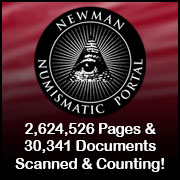
About UsThe Numismatic Bibliomania Society is a non-profit association devoted to the study and enjoyment of numismatic literature. For more information please see our web site at coinbooks.org SubscriptionsThose wishing to become new E-Sylum subscribers (or wishing to Unsubscribe) can go to the following web page link MembershipThere is a membership application available on the web site Membership Application To join, print the application and return it with your check to the address printed on the application. Print/Digital membership is $40 to addresses in the U.S., and $60 elsewhere. A digital-only membership is available for $25. For those without web access, write to: Charles Heck, Treasurer
AsylumFor Asylum mailing address changes and other membership questions, contact Chuck at this email address: treasurer@coinbooks.org SubmissionsTo submit items for publication in The E-Sylum, write to the Editor at this address: whomren@gmail.com BUY THE BOOK BEFORE THE COIN |
- WAYNE'S WORDS: THE E-SYLUM AUGUST 4, 2019
- KOLBE WINS ANA LIFETIME ACHIEVEMENT AWARD
- LAST CALL FOR HAMELBERG LIBRARY TOUR
- KOLBE & FANNING PUBLISH PAPER MONEY CATALOGUE
- BRYCE BROWN AUCTION CATALOG INVENTORY UPDATED
- STACKS-BOWERS SULLIVAN SALE, PART II
- NEW BOOK: BAD METAL
- NEW BOOK: EURO COIN CATALOG
- D. BRENT POGUE (1964-2019)
- ERIC P. NEWMAN NOTES ON VIRGINIA COINAGE
- VIDEO: 2019 SUMMER FUN COIN CONVENTION
- MORE ON MODERN WORLD COIN GUIDES
- QUERY: TWO ENIGMATIC TOKEN INSCRIPTIONS
- NOTES FROM E-SYLUM READERS: AUGUST 4, 2019
- MORE ON U.S. COIN MINTAGE FIGURES
- VOCABULARY TERMS: VARIETY, DISCOVERY PIECE
- DR. AURELIUS DE YOANNA (1861-1952)
- PHILIPPINE PAPER MONEY RESEARCHER "NIEL" NIELSEN
- Q & A WITH MEDAL RESEARCHER SCOTT MILLER
- CHICAGO HALL OF FAME INDUCTS GLENN SMEDLEY
- SPMC 2019 HALL OF FAME INDUCTEES
- WHEN INSTITUTIONS FAIL: PART II
- MINT SELECTS 27 ARTISTIC INFUSION PROGRAM ARTISTS
- EMILY DAMSTRA'S MARY GOLDA ROSS COIN DESIGN
- NUMISMAGRAM MEDAL SELECTIONS: AUGUST 2019
- THE PASIG RIVER COLLECTION
- JOSEPH MICKLEY MEMORIAL MEDAL AND ARCHIVE
- 2019 WORLD'S FAIR OF MONEY EXHIBIT AREA
- MEDIEVAL VENETIAN SILVER COIN FIND
- IRAN GOVERNMENT REVALUES ITS CURRENCY
- THE INVENTION OF MONEY
- SETH DICKERMAN'S COIN PORTRAITS
- LOOSE CHANGE: AUGUST 4, 2019
- MORE ON THE BANK OF ENGLAND MUSEUM EXHIBIT
- FEATURED WEB SITE: COIN HOARDS OF THE ROMAN EMPIRE
Click here to access the complete archive a
Click here to unsubscribe (scroll down)
To comment or submit articles, reply to whomren@gmail.com
Content presented in The E-Sylum is not necessarily researched or independently fact-checked, and views expressed do not necessarily represent those of the Numismatic Bibliomania Society.
WAYNE'S WORDS: THE E-SYLUM AUGUST 4, 2019
 New subscribers this week include: Red Henry. Welcome aboard! We now have 5,943 subscribers.
New subscribers this week include: Red Henry. Welcome aboard! We now have 5,943 subscribers.
Thank you for reading The E-Sylum. If you enjoy it, please send me the email addresses of friends you think may enjoy it as well and I'll send them a subscription (but let me know if they are located in the European Union). Contact me at whomren@gmail.com anytime regarding your subscription, or questions, comments or suggestions about our content.
This week we open with a prestigious award for our society's cofounder, a final call for the Hamelberg library tour, updates from literature dealers Kolbe & Fanning and Bryce Brown, a consignment from former NBS President Michael J. Sullivan, and two new books.
Other topics this week include the passing of D. Brent Pogue, updates to the Newman Numismatic Portal, modern world coin guidebooks, questions and notes from E-Sylum readers, hobby figures "Niel" Nielsen, Scott Miller, Glenn Smedley and more, U.S. Mint Artistic Infusion program artists, and the Joseph J. Mickley memorial medal.
To learn more about George Frederick Kolbe, rare paper money and anti-counterfeiting books, the Virginia coinage, the "LET THE EGLE FLY" token, artificial toning, discovery pieces, collector Dr. Aurelius De Yoanna, F. C.C. Boyd, the Columbian Anacreontic Society medal, artist Emily Damstra, and the invention of money, read on. Have a great week, everyone!
Wayne Homren
Editor, The E-Sylum
KOLBE WINS ANA LIFETIME ACHIEVEMENT AWARD
NBS cofounder George Frederick Kolbe has won the ANA's Lifetime Achievement Award, to be presented at the World’s Fair of Money in Rosemont later this month. Congratulations on a well-deserved recognition! -Editor
The American Numismatic Association (ANA) is honoring several numismatists who not only lead by example, but pave new pathways within the numismatic hobby. Recognized for their dedication, hard work, passion and contributions, these recipients will be acknowledged at the World’s Fair of Money? in Rosemont, Ill., Aug. 13-17.
 The Lifetime Achievement Award is presented to an individual, family, firm or judicial entity that has made outstanding contributions to
organized numismatics. George Kolbe is the 2019 recipient – a numismatist that has combined his love of books and coins to forge a successful
career.
The Lifetime Achievement Award is presented to an individual, family, firm or judicial entity that has made outstanding contributions to
organized numismatics. George Kolbe is the 2019 recipient – a numismatist that has combined his love of books and coins to forge a successful
career.
Kolbe was born in 1941 and began collecting coins when he was 9 or 10 years old. He started selling them in the mid-1960s. Soon, he was buying current and out-of-print reference works on various numismatic topics and auction catalogs. Over several months, his appreciation of books and coins grew into a fledgling career as a numismatic bookseller, long before many specialized in the field.
Kolbe was a familiar face at antiquarian bookstores in Southern California and acquired a bounty of books. In May 1967 he began issuing modest lists of numismatic literature for sale, and his first auction was held in 1976.
Since then, Kolbe has distinguished himself as a promoter of numismatic literature. His scores of auction catalogs and fixed-price lists provide extensive descriptions of the books being offered, covering both their significance as repositories of information and their value as collectable items in their own right. He was the first numismatic bookseller to provide background information relevant to the books’ histories and explain their importance as scholarly sources and artistic objects.
Kolbe has cataloged and conducted more than 150 numismatic literature auctions since 1976 and has issued dozens of fixed-price lists and other publications. The titles featured in these sales span the numismatic spectrum and include works published since the early 16th century. Some are written in languages other than English.
Kolbe has had the opportunity to sell some of the most notable libraries ever brought to market. His sale of highlights from the John J. Ford, Jr. Library achieved the highest price for a single-day numismatic literature sale—$1.66 million. He also sold the Stack Family Library for record prices and the Harry W. Bass, Jr. Library for more than $1 million. His sales of texts for the benefit of the ANA and the American Numismatic Society (ANS) generated funds for new acquisitions, and he has appraised literature donations to the ANA and ANS on behalf of donors, free of charge.
In 1979 Kolbe cofounded the Numismatic Bibliomania Society, and twice has served as editor of its journal, The Asylum. The society honored Kolbe by naming its highest award after him—the George Frederick Kolbe Award for Lifetime Achievement in Numismatic Literature. He belongs to the Antiquarian Booksellers Association of America, International Association of Professional Numismatists and, since 1987, the Rittenhouse Society. He also is a fellow of the Royal Numismatic Society.
In addition, Kolbe has published references about books, coins and medals. His support of niche titles has meant that valuable, but not commercially viable, research is available to collectors. In 2012 he wrote and published The Reference Library of a Numismatic Bookseller, recording the most comprehensive collection of numismatic bibliographies ever assembled, including works published in other languages, dating from 1579 to the present.
In 2010 Kolbe joined forces with David Fanning, Ph.D. to form Kolbe & Fanning Numismatic Booksellers, LLC. Kolbe celebrated his 50th year as an expert in numismatic literature in 2017. To honor the occasion, 28 numismatists contributed to the text Fifty Years of Numismatic Bookselling: A Tribute to George Frederick Kolbe published that year. In the introduction, Fanning wrote, “One of the revolutionary aspects of George’s catalogues was his introduction of formal bibliographic descriptions to an area of the hobby that was used to seeing simple lists of authors and titles. Part of this was salesmanship...but part of this was also an effort on his part to educate others, to share his knowledge.”

LAST CALL FOR HAMELBERG LIBRARY TOUR
Last Call for Hamelberg Library Tour (“Invasion of Champaign”) at the ANA
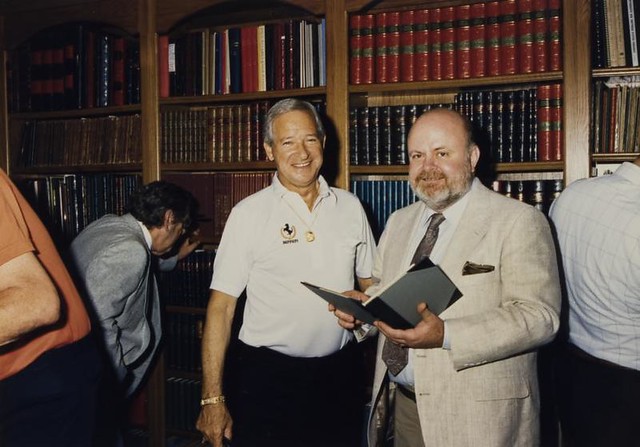
Armand Champa and George Kolbe at the “Invasion of Louisville” (1988)
The Numismatic Bibliomania Society is sponsoring a tour of the Dan Hamelberg numismatic library on Sunday, August 18, following the ANA convention. NBS is providing transportation, but you must reserve a spot with NBS vice-president Len Augsburger (leonard.augsburger@wustl.edu). We will leave from the Rosemont Hilton at 9am and return in the early evening. This is an event not to be missed, a chance to spend a few hours with your fellow bibliophiles in the presence of the premier private library of American numismatic literature.
I'm looking forward to being present at this wonderful event for numismatic bibliophiles. Many thanks in advance to Dan Hamelberg for opening up his home and library to our fellow bibliophiles. -Editor
KOLBE & FANNING PUBLISH PAPER MONEY CATALOGUE
Kolbe & Fanning have produced a specialized catalog of numismatic literature relating to paper money. Here's the press release. -Editor
 Kolbe & Fanning are pleased to announce the availability of our July fixed price catalogue, featuring rare and desirable works on American paper
money. The 127-lot PDF catalogue is divided into two sections--highlights and more common items--and offers a wide variety of material from under $20 to over
$1000. To download the catalogue, visit our website at numislit.com.
Kolbe & Fanning are pleased to announce the availability of our July fixed price catalogue, featuring rare and desirable works on American paper
money. The 127-lot PDF catalogue is divided into two sections--highlights and more common items--and offers a wide variety of material from under $20 to over
$1000. To download the catalogue, visit our website at numislit.com.
A few highlights from this offering include:
--an exceptional copy of Gwynne & Day’s 1859 Descriptive Register of Genuine Bank Notes
--several editions of Heath’s Counterfeit Detectors, including the rare first edition, tenth printing
--a volume of vignettes, portraits and design specimens compiled for Bureau of Engraving and Printing Chief Henry C. Jewell
--Elisha Potter’s rare 1837 work on Rhode Island paper money, the first specialized monograph on American currency
--a splendid copy of the 1819 Society of Arts report on the prevention of counterfeiting
--a rare 1851 Thompson Autographical Counterfeit Detector in an exceptional binding.








The catalogue is being published only in PDF form. No printed catalogue will be issued. It is being distributed first to those customers of ours who have signed up for our email list. You can sign up for our mailing list on our website at numislit.com. Kolbe & Fanning occasionally issues similar fixed price PDF catalogues, so make sure you are among the first to know of them: most items offered are one of a kind.
Please email Kolbe & Fanning at orders@numislit.com or call our office at (614) 414-0855 to purchase items. We look forward to hearing from you.
BRYCE BROWN AUCTION CATALOG INVENTORY UPDATED

Bryce Brown writes:
I've updated my coin auction catalog website to show currently available inventory. For the month of August, E-Sylum readers will get a 15% discount off any order over $100. The first ten such orders received will enjoy a 25% discount.
Great deal! Check out the listing at the link below. -Editor
To visit Bryce's see, see:
http://brycebooks.squarespace.com/

STACKS-BOWERS SULLIVAN SALE, PART II
The second part of Michael Sullivan’s of American counterfeit detector collection is being offered in this month's Stack’s Bowers sales at the American Numismatic Association convention. Here's the press release, which incorporates the full lot descriptions of four highlights. -Editor
The Stack’s Bowers Galleries 2019 ANA Worlds Fair of Money U.S. Currency auction features the second portion of the MJS Collection (Michael Sullivan’s) of American counterfeit detectors and related documents. The live auction session will be held Friday, August 14, 2019 at 5:00 P.M. CDT in room 12-13 of the Stephens Convention Center in Rosemont. The 36 lots were cataloged, like the first part sold in March at Baltimore, by Bruce Hagen, and presented beautifully by the Stack’s Bowers graphic arts team. The MJS collection was formed across over a quarter-century, gathered for its relevance, rarity, beauty and, significantly, its relationships with American paper money. The volumes offered here mirror the later Obsolete Banknote issuing period and most of the descriptions within them provide the only record known of many note types.
This second offering from the collection complements the initial selection sold in March. It is not only vast in scope – like the March sale – but it also maintains the highest standards of quality of such books ever cataloged for sale. The March 2019 offering of the MJS Collection Part 1 emphasized detectors using “rules” such as the initial Foote detectors and most famously, the multiple types of Heath’s that were included. That sale also contained remarkable Autographical and Pictorial detectors. The items offered in the 2019 ANA World’s Fair of Money sale are an important continuation, featuring two other major genres of counterfeit detectors: Descriptive Lists and Bank Note Reporters.
Descriptive Lists are detectors that describe the vignette structures, layouts, and other information of a note for the publisher’s clients to compare banknotes to. The current offering also includes several rare different types of Bank Note Reporters in their original paper wrappers. Most of these are very rare and all are interesting. Related supplements printed by these publishers, such as those featuring coins in circulation, are also cataloged in this second part. The collection of Hodge’s is studied and cataloged in detail. The Dye’s/Hodges’ series is examined and assigned “Sullivan Type” letters.
Of the 18 different types confirmed by Michael, there are 15 cataloged for sale here. The initial 1855 Dye’s Bank Note Delineator offered here is considered the first of its genre, and quickly evolved into the Hodges’ volumes. The descriptive pages were designed as a grid with the vignette details brief due to the small space of each “rectangle” in the grid. However, the quantity of listings in 300 some pages was extensive. These large volumes were usually poorly made, and their tall size made them susceptible to handling and damage, as they were not a perfect fit for standard shelves of the period. Choice, originally bound examples are very rare. The majority of the Hodges’ offered here have been expertly bound in three quarter Morocco leather and are now beautiful and sturdy examples. The examples known, but not in the collection, are featured on an appendix page with diagnostics and pedigrees.
Lot 11112: 1855 Dye’s Bank Note Plate Delineator


Groundbreaking 1855 Dye's Bank Note Plate Delineator
A Fine Copy in its Original Binding
1855 Dye’s Bank Note Plate Delineator. Sullivan Type A. Original Brown Half-Calf. Fine.
 An extremely important volume in the field of counterfeit detectors and the template for the pagination of the Hodges' Bank Note Safe-Guard books
that followed. This is, as originally bound, and in excellent condition. A great rarity.
An extremely important volume in the field of counterfeit detectors and the template for the pagination of the Hodges' Bank Note Safe-Guard books
that followed. This is, as originally bound, and in excellent condition. A great rarity.
Titles and Specifications: Dye, John S. Dye's Bank Note Plate Delineator; A Spurious and Altered Bill Detector, Giving Printed Descriptions of the Genuine Notes of Every Denomination, of All the Banks Doing Business throughout the United States and British North America. Complete. Published by John S. Dye, Exchange Broker, Publisher of "Dye's Bank Mirror," 172 Broadway, Corner of Maiden Lane, New-York, 1855. First edition. Folio 35.0cm by 21.5cm. Original brown half-calf with brown cloth sides. (2), (2), 3-94, 93-94, 95-287, (1) pp. Boarded typographical depictions of bank notes organized 3 by 9 to a page.
Distinguishing Features: Pages 93-94 are in duplicate.
Notes: Only two other examples have been offered at auction in the last 40 years (see Stack's-Kolbe-Ford Library Part I, 2004, lot 427 and Heritage-Newman Part XI, 2018, lot 15206). The deteriorated Newman copy was bound in embossed cloth with a printed lithographic front wrapper. The Newman part XI sale lot description, authored by David Fanning, elaborates on this landmark title: "An extremely rare and important volume. Its groundbreaking status as the first work to provide detailed information on genuine bank notes is stated by Dye in the introductory text: "The Paper currency of the United States is so varied in design, that the Counterfeiters could sport on the ignorance of the people, for no Detector that was ever published described the genuine note, the force of all publications that are devoted to money, being directed towards the spurious, altered and counterfeit." Dillistin (page 146) observes that Dye's groundbreaking work "appears to have had a rather brief existence" but that soon thereafter "J. Tyler Hodges ... undertook the publication of Hodges' New Bank Note Safe-Guard. The description of the notes and the style in which they are presented is identical with that of Dye's Delineator." Dillistin concludes Hodges pirated the Dye publication, but this is now held to be unlikely, given that Hodges's Safe-Guard was published for a number of years, apparently without any objection for Dye, and that the first edition of Hodges would seem to have been printed from the very same plates as Dye'sDelineator--all of which suggests a legal transfer of ownership. Whatever its ultimate legacy, Dye's landmark 1855 work is very rare." Importantly, he also notes the ANS Library lacks a copy and it was not in Champa, Fuld, nor Bass libraries.
Pleasing with its original boards intact and spine details. Internally, exceptional throughout with embossed pagination mostly; bright and handsome. For its type, a Fine and choice copy. Its condition and rarity provide a powerful combination. Contemporary notation on front leaf "West River Bank [Jamaica, Vermont]." Ex: Kolbe Sale 97, March 22, 2002, lot 2. This is a groundbreaking volume indeed in the canon of counterfeit detectors and a beautiful example. Estimate: $2,500 - $5,000.
To read the complete lot description, see:
1855 Dye’s
Bank Note Plate Delineator. Sullivan Type A. Original Brown Half-Calf. Fine.
(https://auctions.stacksbowers.com/lots/view/3-J4VVO/1855-dyes-bank-note-plate-delineator-sullivan-type-a-original-brown-half-calf-fine)
Lot 11113: 1856 Hodges’ New Bank Note Delineator
The Initial, 1856, J.T. Hodges' New Bank Note Delineator
1856 J.T. Hodges’ New Bank Note Delineator. Sullivan Type B. Fine Contents and Finely Bound.
 The first Hodges' title and important as the transition from the 1855 Dyes's using the identical description plates. This 1856
"transitional" type merits much discussion and has been studied for generations by Dillistin and in the modern era by scholars such as Eric Newman
and current bibliophilic catalogers. Finely bound, matching most of the Hodges' in this collection, in impeccable style. These bindings were done by Sam
Ellenport, binder of most of the fine volumes sold in the MJS Collection Part 1 Sale in March 2019.
The first Hodges' title and important as the transition from the 1855 Dyes's using the identical description plates. This 1856
"transitional" type merits much discussion and has been studied for generations by Dillistin and in the modern era by scholars such as Eric Newman
and current bibliophilic catalogers. Finely bound, matching most of the Hodges' in this collection, in impeccable style. These bindings were done by Sam
Ellenport, binder of most of the fine volumes sold in the MJS Collection Part 1 Sale in March 2019.
Titles and Specifications: Hodges, John T. Hodges' New Bank Note Delineator; A Complete Spurious and Altered Bill Detecter, Giving Correct Printed Descriptions of All the Genuine Notes of Every Denomination, of All Banks Doing Business throughout the United States and Canada. The Only Work of the Kind Extant. New-York: Published by Hodges & Company, 1856. First edition. Folio 34.0cm by 21.0cm. Bound in three quarter morocco leather, spine compartments titled in gilt, front board titled in gilt. Printed yellow lithographic front wrapper, 2-page index, title page & verso, 3-310 pp., printed yellow lithographic rear wrap. Boarded typographical depictions of bank notes organized 3 by 9 to a page.
Distinguishing Features: Pages 3-287 are identical to Dye's 1855 work.
Notes: The first work of this genre, as discussed in the prior description, is Dye's Bank Note Delineator, 1855 followed by J. Tyler Hodges 1856 work noted here using the same plates. Dillistin notes that "there can be no question that Hodges' publication was originally prepared from the identical plates used by Dye." Charles Davis concluded "the Dye was published in but a single edition, raising the possibility that one legally succeeded the other." Regardless of what the link between Dye and Hodges was legally, all [researchers] agree Hodges' and Dye's were printed from identical plates and both bear "identical errors in the spelling of place names." The Hodges' work is distinctive for the individual depictions of 27 note layouts per page (9 x 3 format). The depictions visually identify the locations all of primary design elements and their relative positions on the banknotes. J. Tyler Hodges printed the Delineator starting in 1856 then retitled it as the Bank Note Safe-Guard in 1857. Publishing responsibilities transitioned to Daniel M. Hodges, J. Tyler Hodges' brother, resulting in Hodges' American Bank Note Safe-Guard (1861 and 1862 revised edition). Finally, responsibility fell upon Daniel M. Hodges' son, Edward M. Hodges, yielding the 1862 (unknown to Dillistin transition volume, Sullivan Type N as offered in this collection) 1863, 1864, and final 1865 editions.
The only other example traced at auction is the inferior Champa-Newman copy (Bowers & Merena, Champa Part I, November 1994, lot 340, subsequently Heritage's Newman Part XI, November 2018, lot 15307). The Newman Part XI sale lot description discussion is as follows: "The very rare first issue of what came to be known, in subsequent editions, as the Bank Note Safeguard. The Hodges family were publishers of a prominent New York bank note reporter, along with several other similar publications, from the mid-1850s to the mid-1860s. According to Dillistin, this important work was pirated from John Dye's 1855 Bank Note Plate Delineator, but this is almost certainly incorrect. This 1856 issue was unknown to Dillistin and, given that it appears to have been printed from the identical plates used for Dye's 1855 work, it would seem that the copyright had been legally secured. All of the various editions are rare, but the first edition offered here is very rare indeed. The binding on this copy is damp-stained; text generally free of staining, though occasional exceptions are seen. Good to very good." There is also an example in the ANS Library.
This MJS example is a lovely book. Within its elegant Sam Ellenport binding, sharp contents and fully Fine or better, Internal pages clean throughout, but with some penciled corner page marks made in modern era. Yellow wrappers bold, perhaps slightly trimmed at the front. Colorful and exceptionally visual. Ex: Gordon Frost Library sold as Kolbe & Fanning 2012 New York Sale, January 7, 2012, lot 297. Essential to any significant numismatic library and important in the grand scheme of Hodges' detectors.
Estimate: $2,000 - $4,000.
To read the complete lot description, see:
1856 J.T.
Hodges’ New Bank Note Delineator. Sullivan Type B. Fine Contents and Finely Bound.
(https://auctions.stacksbowers.com/lots/view/3-J4VVR/1856-jt-hodges-new-bank-note- delineator-sullivan-type-b-fine-contents-and-finely-bound)
Lot 11124: 1863 Hodges' American Bank Note Safe-Guard


Fully Original Edward M. Hodges'
1863 American Bank Note Safe-Guard-Ex Champa & Ford Libraries
1863 Edward M. Hodges’ American Bank Note Safe-Guard. “Revised and Corrected and Arranged” Edition. Sullivan Type O. Original Decorated Cloth. Fine.
The 1863 Hodges' have two variations that are observed by the grid page details as discussed in the descriptions. This is a lovely and rare book in its original decorated cloth.
Titles and Specifications: Hodges, Edward M. Hodges' American Bank Note Safe-Guard; Giving Fac Simile Descriptions of Upwards of Ten Thousand Bank Notes Embracing Every Genuine Note Issued in the United States & Canada. Revised and Corrected, and Arranged Geographically and Alphabetically. The Most Effectual Detector of Spurious, Altered and Counterfeit Bills Ever Published. The Only Work of the Kind Extant. New-York: Arranged and Published by Edward M. Hodges, 1863. Folio 35.5cm by 22.0cm. Bound in original burgundy decorated cloth with gilt titling. (3), 4-340 pp. Boarded typographical depictions of bank notes organized 3 by 10 to a page.
Distinguishing Features: The Sullivan Type O and Type P versions are nearly identical. They have to be differentiated by comparing the note descriptions. Using page 53 as an example, the O-version describes in column 3, note 7 from the top "People's Bank of Derby Line, VT $10." This same note position in the P- version is "People's Bank of Derby Line, VT $5" and column 3 notes 8 and 0 are "Title of Bank" - no note listed. The first edition to include the U.S. postage currency.
Notes: Most Hodges' extant are in a poor state of preservation since the spines were manufactured weakly and the books were taller than most book shelves. This is superior to most Hodges' encountered.
Fully original and choice; extremely rare as such. The bright pages and bold decorated boards are appealing. There is only very faint looseness in the binding. The appearance of the Postal Currency is key content. Ex: Kolbe & Fanning 2012 New York Sale, January 7, 2012, lot 302; previously in the Champa Library Sale III (Bowers & Merena, 1995, lot 1331) and the Stack's-Kolbe Ford Library Sale I June 1, 2004, lot 592. Exceptional and we can't imagine a finer example in its original binding.
Estimate: $2,000 - $4,000.
To read the complete lot description, see:
1863 Edward M. Hodges’ American Bank Note Safe-Guard. “Revised and Corrected and Arranged” Edition. Sullivan Type O. Original Decorated ...
(https://auctions.stacksbowers.com/lots/view/3-J4W68/1863-edward-m-hodges-american-
bank-note-safe-guard-revised-and-corrected-and-arranged-edition-sullivan-type-o- original-decorated-)
Lot 11126: 1864 Hodges' American Bank Note Safe-Guard


Penultimate Edward M. Hodges' 1864 American Bank Note Safe-Guard
1864 Edward M. Hodges’ Bank Note Safe-Guard. “Revised and Corrected and Arranged” Edition. Sullivan Type Q. Fine Contents and Finely Bound.
The penultimate edition of the historic Hodges' titles and rare. This is another beauty and now richly bound by Sam Ellenport to match the others here. A significant pedigree to the Newman Library.
Titles and Specifications: Hodges, Edward M. Hodges' American Bank Note Safe-Guard; Giving Fac Simile Descriptions of Upwards of Ten Thousand Bank Notes Embracing Every Genuine Note Issued in the United States & Canada. Revised and Corrected, and Arranged Geographically and Alphabetically. The Most Effectual Detector of Spurious, Altered and Counterfeit Bills Ever Published. The Only Work of the Kind Extant. New-York: Arranged and Published by Edward M. Hodges, 1864. Folio 35.5cm by 22.5cm. Bound in three quarter morocco leather, spine compartments titled in gilt, front board compartment with original decorated cloth and gilt titling. (3), 4-340 pp. Boarded typographical depictions of bank notes organized 3 by 10 to a page.
Distinguishing Features: Two inserts bound in; one printed on canary paper.
Notes: This edition's rarity is confirmed from the Newman Part XI sale description and discusses this as follow: "......Original subscription receipt for Hodges' Journal of Finance and Bank Note Reporter affixed to front pastedown; a printed circular for George H. Barker as agent for Hodges tipped in; small yellow printed circular for Barker, advertising various Hodges publications, tipped in at title page. A very rare late edition, lacking from the Champa, Bass and Ford libraries and not represented in the American Numismatic Society Library. Joints cracked and reinforced with cloth tape; spine also reinforced with cloth tape. Overall condition very good." The 1865 "Safe-Guard," published by Edward M. Hodges is Sullivan Type R, but is not included in the collection. It is another extremely rare volume and significantly had the Confederate controlled area's notes removed.
Handsome and bright internally. There are minor restorations to the front wrapper. Inserts are gorgeous. Very handsomely bound like the rest of the set and visually exciting. Ex: Heritage-Ex: Heritage's Newman Part XI Library, November 2018, lot 15315.
Distinctive and extremely rare. The final Hodges' volume in a collection carried across an amazing acquisition tenure of twenty-five years. A feat that might never be duplicated in this scope.
Estimate: $2,500 - $5,000.
A fascinating collection of early bank note detectors from a tumultuous time in American financial history. -Editor
To read the complete lot description, see:
1864 Edward M. Hodges’ Bank Note Safe-Guard. “Revised and Corrected and Arranged” Edition. Sullivan Type Q. Fine Contents and Finely Bound.
(https://auctions.stacksbowers.com/lots/view/3-J4W6H/1864-edward-m-hodges-bank-
note-safe-guard-revised-and-corrected-and-arranged-edition-sullivan-type-q-fine- contents-and-finely-bound)
To read the earlier E-Sylum article, see:
SELECTIONS FROM THE STACKS-BOWERS SULLIVAN SALE
(https://www.coinbooks.org/v22/esylum_v22n05a02.html)
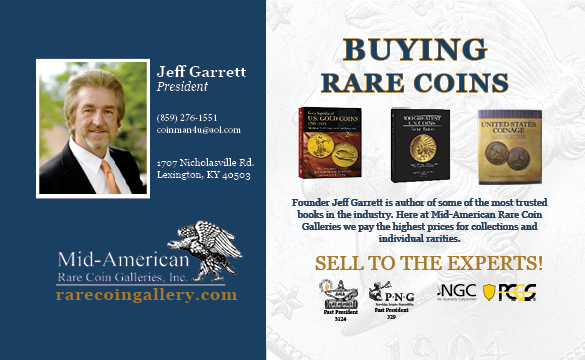
NEW BOOK: BAD METAL
Winston Zack's long-awaited book on circulating contemporary counterfeit coins has been published. It's the first in a planned three-part series. Here's the press release. -Editor
Bad Metal: Copper and Nickel Circulating Contemporary Counterfeit United States Coins
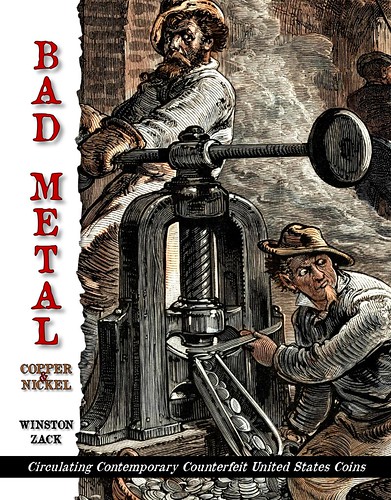 Love them or loathe them, circulating contemporary counterfeit United States coins were an integral component in shaping the early history of the
United States, and surviving examples remain embedded in our numismatic hobby today. Until recently, intensive research on this important subject has been
largely overlooked by scholars. This book eclipses and unifies that prior research, while adding extensive original analysis, information, and documentation on
these forgotten yet intriguing pieces of history.
Love them or loathe them, circulating contemporary counterfeit United States coins were an integral component in shaping the early history of the
United States, and surviving examples remain embedded in our numismatic hobby today. Until recently, intensive research on this important subject has been
largely overlooked by scholars. This book eclipses and unifies that prior research, while adding extensive original analysis, information, and documentation on
these forgotten yet intriguing pieces of history.
This book provides an in-depth and often exhaustive examination on the history of circulating counterfeit United States coins. It clarifies common misconceptions and preconceived ideas, dispels myths, and corrects misinformation about circulating counterfeit United States coins which have circulated in this hobby for many decades. Hundreds of large, high-quality, and professional color photographs make it easy to identify different counterfeit coin types and varieties in order to better illustrate this subject.
Specifically, this book covers the differences between die struck and cast counterfeit coins, along with extensive analysis on how to quickly and easily identify a contemporary counterfeit United States coin with confidence. Additional chapters comprise counterfeit United States coin laws, counterfeiter behaviors, and the history of United States coin counterfeiting through the end of the 19th century. This book concludes with chapters thoroughly analyzing documented contemporary counterfeit United States copper denominations (half-cents, large cents, small cents, two cents), as well as copper-nickel denominations (three-cent, and five cent Shield, Liberty, Buffalo, and Jefferson). These last two chapters include extensive research to identify who made specific counterfeit coin varieties thus establishing the provenance for many of these largely mysterious numismatic pieces.
This book will be of immense interest to anyone who collects and handles United States coins, is interested in United States coinage history, or just general history about the United States since the late 18th century. This is the first book in a planned three-part series on circulating contemporary counterfeit United States coins. The two other books will cover silver and gold counterfeits, and will be published over the next couple years.
Winston Zack is a life member of the American Numismatic Association, Chicago Coin Club, John Reich Collectors Society, and the Central States Numismatic Society.
Bad Metal: Copper and Nickel Circulating Contemporary Counterfeit United States Coins
Author: Winston Zack
Format: Hardcover
ISBN-13: 9781513651866
Pages: 320, full color
Pub. date: 10 November 2019
Publisher: Sheridan Books Incorporated
Presale Price: $69/shipped (U.S.)
To read the complete article, see:
Bad Metal – Copper and Nickel Counterfeits
(https://www.badmetalcoin.com/product-page/bad-metal-copper-and-nickel)
THE BOOK BAZARRE
NEW BOOK: EURO COIN CATALOG
Tom Michael alerted me to the new edition of Gerhard Schön's catalog of Euro coins. See the article later in this issue about modern coin catalogs. Here's the Google-translated text from the publisher's web site. -Editor
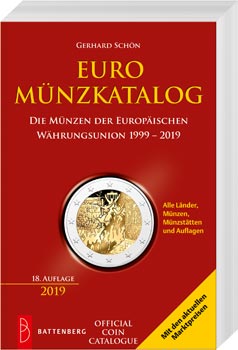 Euro Münzkatalog
Euro Münzkatalog
Die Münzen der Europäischen Währungsunion 1999 – 2019
Euro coin catalog
The coins of the European Monetary Union 1999 - 2019
Publisher: Battenberg Verlag
ISBN: 978-3-86646-172-7
Edition: 18th completely revised and revalued edition 2019
Illustrations: numerous black and white illustrations
Paperback: 1712 pages
Format: 12.5 x 19 cm
Description
• 18th edition 2019: the top seller among the Euro coin catalogs
• clear and complete
With the euro coin catalog by Gerhard Schön, the collector is well advised and has a reliable and clearly arranged source of information in his hands. The 18th edition of this top seller was again revised and adapted to the developments of the last year. All coins have been valued for current market activity taking into account the latest price developments. They are shown in original size with front and back. All previously published and announced euros are recorded and provided with the actual embossing numbers.
The collector receives a complete overview of all circulation coins, commemorative coins, course coin sets and starter kits and all important information for him, which are easily understandable and clearly presented: weights and embossing numbers by age groups and mints, motif explanations, margins, coin designers, issue dates and above all the current market prices.
• all coins in original size with front and back shown
• All previously published and announced Euros are recorded
• with the actual embossing numbers
• taken into account latest price developments
For more information, or to order, see:
Euro Münzkatalog Die Münzen der Europäischen Währungsunion 1999 – 2019
(https://www.battenberg-gietl.de/sammeln/buch/euro-muenzkatalog)
D. BRENT POGUE (1964-2019)
Collector/dealer D. Brent Pogue passed away at the young age of 54. With permission, we're republishing Dave Bowers' remembrance from his Stack's Bowers blog, published August 2, 2019. -Editor
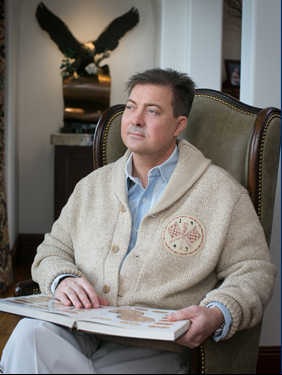 It was with great sadness that I and others learned of the unexpected passing of D. Brent Pogue, quietly in his home. I have had the privilege and
honor of knowing and working with Brent ever since he entered numismatics in the 1970s, and in recent years all of us at Stack’s Bowers Galleries have
partnered closely with him and his family in the sale by auction in five events, of his extraordinary collection of early American federal coins from the 1790s
through the 1830s. Brent was the very definition of an extraordinary numismatist, a connoisseur. A careful student with a fine library at hand, he researched
every coin he hoped to add to his collection.
It was with great sadness that I and others learned of the unexpected passing of D. Brent Pogue, quietly in his home. I have had the privilege and
honor of knowing and working with Brent ever since he entered numismatics in the 1970s, and in recent years all of us at Stack’s Bowers Galleries have
partnered closely with him and his family in the sale by auction in five events, of his extraordinary collection of early American federal coins from the 1790s
through the 1830s. Brent was the very definition of an extraordinary numismatist, a connoisseur. A careful student with a fine library at hand, he researched
every coin he hoped to add to his collection.
In connection with our offering of his coins I and Christine Karstedt interviewed him several times, learning the story of his adventures in numismatics. Brent was born in Dallas on December 19, 1964. It has been said that some people are endowed with a collecting spirit and intellectual curiosity from birth, and for Brent this was certainly true. Starting as a teenager and with the guidance of his father Mack, Brent with connoisseurship, knowledge, and persistence built the finest-ever collection of early American federal coinage of the early years. No other private or museum collection past or present has come even close to his achievement.
In 1974 his dad, Mack, a nationally-known real estate developer based in Dallas, brought home a large bag filled with wheat-back Lincoln “pennies,” the type made before 1959. He had bought it from his brother Jack for $100. Mack, with a keen eye on encouraging entrepreneurship, gave it to Brent with an option to buy it for $110 within a week. Brent took it to his room, and with a copy of the Guide Book at hand, proceeded to go treasure hunting. Before long he found a 1915 cent that was as bright as new! It was worth $65!
“I was immediately hooked,” Brent recalled.
That was not all, Brent continued. “My first thought, since there was no mintmark, was ‘How did this penny make it from Philadelphia to Dallas? Then I asked myself ‘who was the president of the United States in 1915? What else was happening that year?’ Only after that did I think about the business side. I walked into my father’s bedroom. He was reading the newspaper. I exercised my option the same day.”
The rest, they say, is history: as the familiar comment goes. And what a nice history it has been from that day 45 years ago up to the present time. After having looked through the bag of cents and having immersed himself in reading the Guide Book from cover to cover, Brent expanded his horizons. Using the local bus he went to North Dallas to visit Ed Hipps’ coin shop and talk with the owner. “He was always so kind to me,” Brent recalls, although “I was hardly his biggest client.” From that point Brent became a dealer of sorts, in a modest way. In his words:
“In 1974 I was in elementary school. I walked to school every morning. Didn’t everybody? I was not allowed to cross busy Douglas Avenue on the way. I broke the rule one day, crossed, and went into a 7-11 store where I purchased two jawbreakers for two cents.
“Each day the bell would ring calling us to class. Until then, my classmates and I would play touch football on the school’s grass field. On this particular day I had one of the jawbreakers in my mouth. A friend of mine asked if he could have the other. I said ‘no.’ He said he would give me an 1855 half dollar for it. It was at his house. I did not let him out of my sight that day and followed him home after class. He found the coin. The next day I sold it to another one of my friends for $16. It was off to the races! Coins were a fixture in my life from then on.”
Brent expanded his numismatics interest further and began building a fine reference library of auction catalogs and standard works. In 1978 his dad, having been an observer up to this time, joined him in numismatics. A familiar comment from Brent was “I was the steering wheel and my dad was the gas.” Both followed the market and participated in many sales.
In 1979 when Bowers and Ruddy Galleries conducted the first of four sales of the Garrett Collection for the Johns Hopkins University, Brent and Mack participated. In 1982 in the same firm’s sale of the Louis E. Eliasberg U.S. Gold Coin Collection, Brent and his dad were front row center during the preview. For the sale itself Brent was beside himself as he had to travel back to Dallas to participate in a track meet. The Pogues kept their eyes on the important coins in the sale—the only 1822 half eagle in private hands and the only 1854-S half eagle privately owned. In the end, Mack telephoned Brent, “We got them both!”
Speaking of the track meet, Brent was an athlete in several venues, ran marathons and triathlons, and participated in ocean swims. Recreational sports continued to be a lifetime passion.
Brent enrolled in the University of Texas at Austin and in 1987 was awarded a degree in economics. After that he worked with Goldman Sachs on Wall Street for three years as an analyst in that firm’s real estate department. In 1990 he went to work for the family business, the Lincoln Property Company based in Dallas, but with their New York City office. Next was a move to the Chicago office, followed a few years later to a move back to Dallas where he helped form a mortgage acquisition business as a subsidiary of Lincoln and established the Praedium Fund. In that capacity Brent moved to Los Angeles as an asset manager. “That went on for several years until my passion for coins overwhelmed me.”
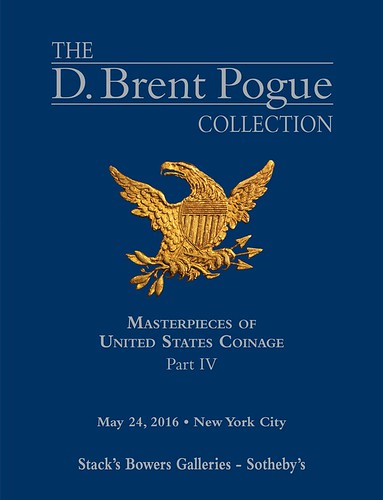 In 2001 Brent went into rare coins full time and turned his passion into a business. While adding to his own collection he attended many conventions
and auctions to buy and sell. His first major transaction was the purchase of a type set of copper and silver coins from Stack’s in 2002. In 2003 he completed
the acquisition of the Foxfire Collection formed over a long period of years by Claude Davis, M.D. In 2005 he negotiated for and completed the purchase of the
Great Lakes Collection of $3 gold, complete except, of course, for the 1870-S. This was the finest known such collection at the time, replete with many
gems.
In 2001 Brent went into rare coins full time and turned his passion into a business. While adding to his own collection he attended many conventions
and auctions to buy and sell. His first major transaction was the purchase of a type set of copper and silver coins from Stack’s in 2002. In 2003 he completed
the acquisition of the Foxfire Collection formed over a long period of years by Claude Davis, M.D. In 2005 he negotiated for and completed the purchase of the
Great Lakes Collection of $3 gold, complete except, of course, for the 1870-S. This was the finest known such collection at the time, replete with many
gems.
Figuratively, “I have fallen asleep with a coin book on my chest every night, from the beginning. Adding to my pleasure has been working with you as well as other leading dealers and auction houses,” he commented.
Brent had other interests than coins, in case readers wonder. He lived in California, where he enjoyed making headway on his golf game. Over a long period of time he went to many places and did many things, traveling in America and in foreign lands. On the personal side, he was a close friend in other areas, such as visiting Wolfeboro, New Hampshire and being a house guest, also visiting with Chris Karstedt and her family. Among his adventures was driving a boat on Lake Winnipesaukee. More daring was something I did not know about until after it happened. One day during a visit here he and my son Andrew decided to go sky diving. They drove over to the coast of Maine and did exactly that—proudly returning to tell their parents after the fact.
Brent was a superb host to us both in Dallas and in California and also the definition of a kind, generous person. Combining his personality with his coin collecting I can say that he ranks among the finest of all people in numismatic history.
Now, I and his other friends are only left with memories.
To read the complete article, see:
Remembering D. Brent Pogue
(https://www.stacksbowers.com/News/Pages/Blogs.aspx?ArticleID=Remembering-D-Brent-Pogue)
To read earlier E-Sylum articles, see:
NEW BOOK: THE D. BRENT POGUE RARE COIN CABINET (https://www.coinbooks.org/esylum_v18n06a05.html)
ARTICLE PROFILES D. BRENT POGUE (https://www.coinbooks.org/esylum_v18n13a15.html)
BUILDING THE D. BRENT POGUE COLLECTION (https://www.coinbooks.org/esylum_v19n16a05.html)
BRENT POGUE BOUGHT THE BOOKS BEFORE THE COINS
(https://www.coinbooks.org/v20/esylum_v20n16a09.html)

ERIC P. NEWMAN NOTES ON VIRGINIA COINAGE
The latest additions to the Newman Numismatic Portal are Eric P. Newman's notes on Virginia Coinage. Project Coordinator Len Augsburger provided the following report. -Editor
Eric P. Newman Notes on Virginia Coinage added to Newman Portal
![virginiacoinspaste1960epnarchives_0012[1] (2)](https://live.staticflickr.com/65535/48447245237_c0854ae892_n.jpg) Recently added to Newman Portal are Eric Newman’s research files on Virginia coinage. Newman, as usual, casts a wide net, corresponding with
institutions and individuals including the Royal Mint, the U.S. National Archives, Colonial Williamsburg, Virginia Historical Society, Morton Stack, and
others.
Recently added to Newman Portal are Eric Newman’s research files on Virginia coinage. Newman, as usual, casts a wide net, corresponding with
institutions and individuals including the Royal Mint, the U.S. National Archives, Colonial Williamsburg, Virginia Historical Society, Morton Stack, and
others.
Correspondence with the American Numismatic Society regarding Newman’s publication on the subject, Coinage for Colonial Virginia (Numismatic Notes and Monographs, no. 135, 1956) is included here. This reveals an interesting tidbit regarding the dedication of this work to Newman’s wife Evelyn (“Dedicated / to / my wife Evelyn / who, prophetically, was wearing / a necklace of coins / when we first met”). The ANS was reluctant to publish this but Eric was insistent, as noted in correspondence to the ANS on November 2, 1956. This file also includes the photographic pasteups used for the ANS article.
Image: Cut from plate 5 of Coinage for Colonial Virginia (1956) depicting nine-string harp reverse, struck from a die in the Royal Mint Museum
Link to Eric P. Newman research files on Virginia coinage:
https://nnp.wustl.edu/library/archivedetail/533004
VIDEO: 2019 SUMMER FUN COIN CONVENTION
These are selections from the David Lisot Video Library that feature news and personalities from the world of coin collecting. David has been attending coin
conventions since 1972 and began videotaping in 1985. The Newman Numismatic Portal now lists all David’s videos on their website at:
https://nnp.wustl.edu/library/multimediadetail/522852
Here's one on the Summer FUN Coin Convention. -Editor
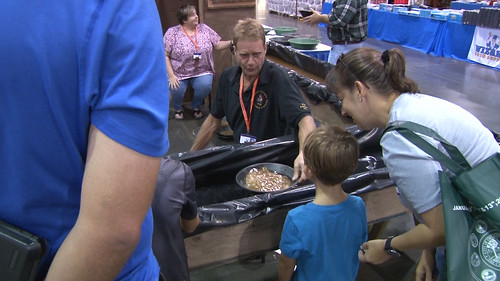 Summer FUN Coin Convention Offers Something for Everyone.
Summer FUN Coin Convention Offers Something for Everyone.
VIDEO: 2:26.
David Lisot, Interviewer, CoinTelevision.com with John McIntosh, George Watson, & John Yasuk. Have you ever been to a coin convention? Not only are there coins to buy and sell there is much more. Find out why people attended the Summer Florida United Numismatists Coin Convention.
An excerpt of the video is available for viewing on the Coin Television YouTube Channel at:
https://youtu.be/tJaF7zVbnpg
This video is a highlight from FUN Summer Coin Convention Highlights 2019

MORE ON MODERN WORLD COIN GUIDES
Last week we discussed the new edition of the Directory of Circulating Coins published by Currency News. Pabitra Saha notes that competitors "Krause (SCWC) and WMK are thick tomes, covering all type of fantasy and commemorative coins where the actual usable coins get lost in overload of information."
Our readers are familiar with the standard Catalog of World Coins 2001-Date, which I noted was just updated last year with the 13th edition for 2019. The WMK guide is the book I asked about last week - It's published in Germany. -Editor
Regarding the German publisher, B. J. Herbison writes:
That would be the Schön catalogs. They have 20th and 21st century books like Krause, but with much more detailed information on mints and privy marks for recent issues. I've been using Schön more as the recent Krause catalogs have gotten further behind and reduced in quality. (And even when both are good I learn by comparing the two catalogs and my coins.)
I've never seen the Directory of Circulating Coins so I can't give any information on which has better current information.
I also use on-line sites, Numista most commonly for general use. Numista has KM numbers for most coins, Schön for many, and additional collected
information on variations. For an example see the comments section in
https://en.numista.com/catalogue/pieces1474.html .
I contribute a little to Numista; many people spend hours updating the information.
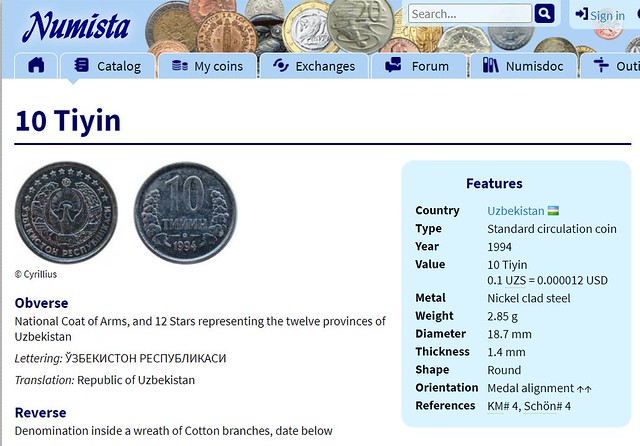
Tom Michael of AIM - Krause Publications writes:
That would be Battenberg Gietle-Verlag. They publish a very good series of books covering time spans similar to the Standard Catalog of World Coins.
Their 21st Century edition is no longer in print, I believe, however they do publish a nice edition covering the EU:
https://www.battenberg-gietl.de/sammeln/buch/euro-muenzkatalog .
My good friend Gerhard Schön is the author of this catalog and Gerhard also authors a 20th Century edition, a 19th Century edition and here is his
latest 18th Century edition:
https://www.battenberg-gietl.de/sammeln/buch/deutscher-muenzkatalog-18-jahrhundert .
Production of these catalogs is less cyclical than the SCWC's, though I do know that Gerhard is completing a new edition of the EU catalog every year. Prior to establishing the EU catalog, the 21st Century catalog was done annually for just a few years before dropping out of sight about two years ago. It is a tremendous task to keep up with 21st Century coin production.
Thank you. Numismatic publishing is a small world. I added an article about the new Euro coin catalog at the top of this issue. Below are images and links to the publisher's pages for the Schön Welt Weltmünzkatalog (WMK).


For more information, or to order, see:
Weltmünzkatalog 20. Jahrhundert, 1901 - 2000
(s://www.battenberg-gietl.de/sammeln/buch/weltmuenzkatalog-20-jahrhundert-1901-2000)
Weltmünzkatalog 21. Jahrhundert, 2001 - 2016
(https://www.battenberg-gietl.de/sammeln/buch/weltmuenzkatalog-21-jahrhundert-2001-2016)
Thanks, everyone. -Editor
To read the earlier E-Sylum article, see:
NEW BOOK: DIRECTORY OF CIRCULATING COINS 3RD ED.
(https://www.coinbooks.org/v22/esylum_v22n30a03.html)

QUERY: TWO ENIGMATIC TOKEN INSCRIPTIONS
In a July 31, 2019 Stack's Bowers blog article, Dave Bowers seeks assistance regarding two enigmatic tokens. I wasn't familiar with the "Let the E[a]gle Fly" piece. Can anyone help? -Editor

At the ANA World’s Fair of Money in Rosemont two weeks from now I invite you to track me down at the show and talk about anything on your mind—from consigning to an upcoming sale to research on something obscure in American numismatics. Or just to say hello.
One of my current book projects is about mottos and inscriptions on coins, tokens, and notes used as money. There are many puzzles, such as the one illustrated and described below:
This copper token represents one of many enduring mysteries in numismatics. The obverse depicts a face representing the sun, with resplendent rays surrounding. The inscription reads: LET THE EGLE FLY / J.S.G.S.L.C.O. A dozen or so examples are known today, each of which is well-circulated. These are not numismatic issues made for collectors but in their time were used in circulation.
Russell Rulau in his Standard Catalog of U.S. Tokens 1700-1900 noted that David Proskey considered this to be a pattern Mormon $10, and in 1888 Proskey expressed the view that J.S.G.S.L.C. signified "Joseph Smith, Great Salt Lake City." Rulau noted that the letters in the inscription are J.S.G.S.L.C.O., and that Proskey never conjectured about the meaning of the final "O." Perhaps if Proskey were cataloging the same piece today he would conjecture instead "Joseph Smith, Great Salt Lake Coinage Office." Rulau thought the piece was actually a token dated to the era between 1846 and 1848, which prompts us to wonder why he chose to list this variety in his catalog of trade tokens dated 1866 to 1889 rather than in his merchant token list 1845 to 1860. Rulau omits pricing for the variety in all grades.
Modern opinion is divided and the attribution of this token has been a matter of considerable discussion. The Internet site www.earlymormoncollectibles.com showcases this token as a Mormon issue, citing David Proskey, and valuing it at $4,500. The Mormons did not establish Great Salt Lake City until 1847, the year after the date of the token. And yet, the letters J.S.G.S.L.C. are sufficiently distinctive that it would be difficult to assign any other attribution. As to the initials J.S., these letters could relate to the founder of the religion, Joseph Smith, who was killed in 1844.
What do the inscriptions mean? The token, though dated 1846, could have been made later when Great Salt Lake City was a reality. In any event, Joseph Smith was a memory. "Let the E[a]gle Fly" could relate to some hope that Smith's aspirations or indeed the Mormon faith would take wing. Again, there is room for conjecture and little in the way of fact. In an Internet discussion with Bob Leonard in early 2013, I said that I felt that it does have a Mormon connection, but the circumstances of issue have yet to be determined. Today in 2019 I have learned nothing new. One thing remains clear, that this is an interesting early American token of considerable rarity, one that holds a secret, perhaps very important, that is still to be discovered.
I need help on another mystery, the meaning or translation of the inscription FERTILITATEM DIVITIAS QUE CIRCUMFERREMUS on the obverse of the 1794 Copper Company of Upper Canada halfpenny (see image). At the center is the reclining figure of a river god in the style of Neptune.
Dave's serious about his offer to chat at coin shows. I've taken him up on this many a time. Shows are a wonderful opportunity to engage face-to-face with hobby leaders and fellow collectors and researchers. I'll be at the show myself Thursday-Saturday and look forward to seeing many of our readers at Numismatic Bibliomania Society events and everywhere in between. -Editor
To read the complete article, see:
The Enigmatic “Let the Egle Fly” Token
(https://www.stacksbowers.com/News/Pages/Blogs.aspx?ArticleID=let-the-eagle-fly)

NOTES FROM E-SYLUM READERS: AUGUST 4, 2019
Remembering Simon Bendall
Frank S. Robinson writes:
 A good many years ago at the New York coin show I came upon an unidentified coin, patinated green, seemingly a Byzantine bronze scyphate. I puzzled
over it as it appeared to be an unusual type, not one of the many I was familiar with. Well, it was cheap, so I bought it.
A good many years ago at the New York coin show I came upon an unidentified coin, patinated green, seemingly a Byzantine bronze scyphate. I puzzled
over it as it appeared to be an unusual type, not one of the many I was familiar with. Well, it was cheap, so I bought it.
Just a few minutes later, I ran into Simon Bendall (I’d had some interactions with him before). So I showed him my new acquisition. “It’s a silver coin,” he said immediately. “Constantine IX.” Just like that. I was blown away by such depth of knowledge and memory.
That attribution was far from obvious, but of course he was right. The green patina came off revealing a silver coin, and fairly rare, of Constantine IX.
Only days ago I got a group of Michael VIII scyphates, a couple of which aren’t in his book. Running some pictures past Simon was the obvious thing to do, but now it’s moot. What a loss to numismatics.
To read the earlier E-Sylum article, see:
SIMON BENDALL (1937-2019) (https://www.coinbooks.org/v22/esylum_v22n30a10.html)
"The Coins Tone Themselves"
Bob Leonard writes:
Recent "crazy" prices for otherwise common high-grade U.S. coins with colorful toning remind me of something I learned long ago. In the early 1960s I was collecting modern world coins and visited the downtown Chicago office of dealer Frank Lapa from time to time. (Lapa later went bad and died in prison.) One day he had a selection of very recent (1960-61 or so) uncirculated minor world coins with what he called "crazy" toning for sale; it was obvious that these coins had not toned naturally, but they were certainly colorful. (They weren't particularly expensive, but I didn't buy any.)
Frank told me that one of his customers was toning them. This man would not reveal his process, but said "the coins tone themselves." Clearly it did not take very long, and worked on copper-nickel and copper coins too.
In bringing this up now, I am not suggesting that any of the coins sold recently at huge prices were artificially toned, or that the grading services are unable to detect fake toning. However, the greatest demand originally was for Morgan dollars, then classic commemorative half dollars, and now we are seeing Washington quarters and Mercury dimes. So we need to be vigilant, because the process for adding "crazy" toning to smaller coins has been around for over half a century.
Thanks. An interesting addition to our earlier discussion on coin "doctoring" and conservation. Of course, it's true in a way that "The Coins Tone Themselves". People may provide the conditions that encourage or speed the toning process, but it's still a natural process. No one is dipping them in paint. -Editor
To read earlier E-Sylum articles, see:
ON NUMISMATIC DOCTORING AND CONSERVATION
(https://www.coinbooks.org/v22/esylum_v22n22a11.html)
MORE ON NUMISMATIC DOCTORING AND CONSERVATION
(https://www.coinbooks.org/v22/esylum_v22n23a14.html)
Ship of Gold in the Deep Blue Sea
Regarding literature on the S.S. Central America, Ronald Fritz writes:
 I'd like to call readers' attention to another good book about the original discovery, Ship of Gold in the Deep Blue Sea by Gary
Kinder. I purchased my copy from a bookstore in the trade center a few months before 9/11. I have lent it to many friends, both numismatists and noncollectors,
and all thoroughly enjoyed the book.
I'd like to call readers' attention to another good book about the original discovery, Ship of Gold in the Deep Blue Sea by Gary
Kinder. I purchased my copy from a bookstore in the trade center a few months before 9/11. I have lent it to many friends, both numismatists and noncollectors,
and all thoroughly enjoyed the book.
Thanks. I read that book early on and it's indeed a great one. Copies can be found cheaply online. -Editor
To read earlier E-Sylum articles, see:
RECOMMENDED READING: SHIP OF GOLD (https://www.coinbooks.org/esylum_v02n32a04.html)
SHIP OF GOLD BOOK (https://www.coinbooks.org/esylum_v06n39a19.html)
QUERY: WILL 'SHIP OF GOLD' BECOME A FILM?
(https://www.coinbooks.org/esylum_v15n48a20.html)
MORE ON THE SHIP OF GOLD FILM (https://www.coinbooks.org/esylum_v15n49a10.html)
NEW BOOK: AMERICA’S GREATEST TREASURE SHIP
(https://www.coinbooks.org/v22/esylum_v22n30a02.html)
More on Irradiated Dimes
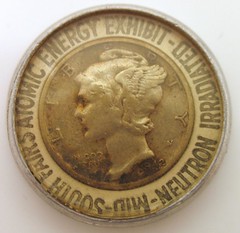 Ken Berger notes that we had a few earlier E-Sylum articles on irradiated dimes, which I'd run out of time to add links to following
the article Joe Esposito had sent for last week's issue. Thanks. -Editor
Ken Berger notes that we had a few earlier E-Sylum articles on irradiated dimes, which I'd run out of time to add links to following
the article Joe Esposito had sent for last week's issue. Thanks. -Editor
To read the earlier E-Sylum articles, see:
IRRADIATED DIMES (https://www.coinbooks.org/esylum_v14n51a07.html)
MORE ON IRRADIATED DIMES (https://www.coinbooks.org/esylum_v14n52a10.html)
KEN BERGER PUTS IRRADIATED DIMES TO THE TEST (https://www.coinbooks.org/esylum_v15n03a11.html)
THE OAK RIDGE DIME IRRADIATOR (https://www.coinbooks.org/v22/esylum_v22n30a25.html)
More on Strange Good Luck Symbols
Bill Hyder writes:
 Your mention of the strange good luck symbols caught my eye. Another professional interest of mine is the study of prehistoric rock art, i.e.
petroglyphs and pictographs. Several researchers have focused on petroglyph sites called Western Message Glyphs found throughout the American West, often
associated with travel routes, early mining activities, etc. They most likely date from the late 1800s and early 1900s, i.e. they overlap with the Good Luck
tokens displaying strange symbols and the "Don't Worry" philosophy and clubs.
Your mention of the strange good luck symbols caught my eye. Another professional interest of mine is the study of prehistoric rock art, i.e.
petroglyphs and pictographs. Several researchers have focused on petroglyph sites called Western Message Glyphs found throughout the American West, often
associated with travel routes, early mining activities, etc. They most likely date from the late 1800s and early 1900s, i.e. they overlap with the Good Luck
tokens displaying strange symbols and the "Don't Worry" philosophy and clubs.
I have referred Craig Murray's website to a few of the researchers and will now refer their work to Craig. So far, there does not appear to be a one-to-one overlap in symbols, but both appear at a time when fascination with Mayan, Aztec, Ogam, Egyptian glyphs became popular in American literature. While they may be unrelated, I suspect the development of the quasi-symbolic systems has the same roots.
Interesting! I wasn't aware of that, but I'm not surprised. Makes sense. Thanks for making the connections. -Editor
To read the earlier E-Sylum article, see:
NOTES FROM E-SYLUM READERS: JULY 28, 2019 : More on Strange Good Luck Symbol
(https://www.coinbooks.org/v22/esylum_v22n30a15.html)
Correction: Battle of Rorke's Drift
Regarding the date of the Battle of Rorke's Drift mentioned in last week's article about a display of Anglo-Zulu war medals, Chip Howell writes:
The original story has it wrong (misleading, at best): Rorke's Drift was in JANUARY, not July (22-23rd, 1879). So, while it is the 140th year since the battle (and the 55th since Stanley Baker's "Zulu"), the actual anniversary was six month's ago.
George Reynolds also caught this boo-boo. Thanks, guys. I never even thought to look that up. -Editor
To read the earlier E-Sylum article, see:
1879 ANGLO-ZULU WAR VICTORIA CROSS EXHIBIT
(https://www.coinbooks.org/v22/esylum_v22n30a26.html)

MORE ON U.S. COIN MINTAGE FIGURES
Tom Caldwell of Northeast Numismatics writes:
"Seeing the recent articles on E-Sylum reminds me of something I noticed years ago in the way that proof mintages have been reported in the Red Book & the way they are reported now. Look at an old red book & you will note that the mintage figures reported for business strikes do not distinguish whether the amount listed includes proofs or not. Next, compare any given coins mintage figures in early editions with more recent ones & all business strike mintages are now listed as less by the amount of the proof mintages. So the mintages did not really change; they are simply reported more accurately today.
"There are however instances where some mintages did truly change (sort of)...
"Take the case of an 1879 quarter in proof which early editions of the Red Book report at 250. Back in the day (in the early 1970’s) when first traveling to shows it was well known that something was wrong with this mintage figure. There were way too many on the market; pretty much an equal amount of this year as other comparable years of the era. We would advertise them as “the lowest reported mintage figures” of the series, which at 250 pieces simply did not compare with all others from 1858 to 1891 - those with much higher published figures. Who were we to question the Red Books reporting? Well at some point this figure was indeed questioned & now the figure listed is 1100. So, were 850 pieces suddenly minted over a century late? Was a hoard discovered??
"As another example, this past week we had a client interested in an 1858 seated dollar in proof that is on the market & he mentioned there were 210 pieces minted. I shot back, correcting him, saying there were only 80 pieces (it takes a real old-time coin weenie to remember random mintages). Later I was curious if this might be a case of changing mintages. Sure enough, the 80 piece number I recalled was correct in my ‘early Red Book mind’ only to be changed to what is now considered more accurate - 210 as reported in recent editions.
"The reporting of mintage figures in the 19th century, proofs in particular, was not always accurate. Through research, new information comes to light, new documents discovered & although mintage figures do not technically change, they do become more reliable & accurate."
I reached out to Redbook Editor Emeritus Ken Bressett, who writes:
 "Tom’s letter presented the procedure very accurately. The Whitman editors always strive to include the latest information in all of their
books. Some of this comes from dedicated readers who share their research and insights to help keep the books as accurate and up to date as possible. “Best
estimate” mintage figures are presented in italics, and given as a guide when there is no more reliable information.
"Tom’s letter presented the procedure very accurately. The Whitman editors always strive to include the latest information in all of their
books. Some of this comes from dedicated readers who share their research and insights to help keep the books as accurate and up to date as possible. “Best
estimate” mintage figures are presented in italics, and given as a guide when there is no more reliable information.
"Making these adjustments is an on-going process. The move to segregate the Proof figures from the Uncirculated totals came about as a well-considered decision to change from the past, and make those listings more accurate and understandable. The needs and desires of readers are always carefully considered when making major editorial changes and are often reviewed by a number of numismatic experts."
Thanks! Reverse-engineering the myriad changes to the book over the years could be an interesting project. It's important to know it's an ever-evolving work, with far more than mere price updates from year to year - it's the accumulated experience of decades of dedication. -Editor
To read the earlier E-Sylum article, see:
COUNTING U.S. COIN MINTAGE FIGURES (https://www.coinbooks.org/v22/esylum_v22n29a12.html)

VOCABULARY TERMS: VARIETY, DISCOVERY PIECE
Dick Johnson submitted these entries from his Encyclopedia of Coin and Medal Terminology. Thanks! -Editor
Variety. A numismatic item differing from all other items of the same type, even if the difference is minute. Such a difference is the result of a change in the die (if struck),
or in the mold (if cast), as re-engraving a die crates a new variety. Numismatists study these variations. The greatest number of varieties occur in changing the date, somewhat less in the lettering or detail. A major variety can be the addition or deletion of a single word of a single character, or change in a design element; a minor variety would be, for example, a broken die with part of a letter filled. See die variety.
Discovery Piece. A numismatic item whose variety was heretofore unknown to numismatists and is correctly identified and reported by the discoverer. To be credited with the discovery, the numismatist-discoverer must do the following: (1) know exactly what he has discovered, (2) he must correctly identify and describe the variety; and (3) he must report it in the numismatic press. Further, but out of his control, the identification must stand the test of time to be accepted into numismatic literature.
Often it is a cataloger, an employee of an auction house, or a dealer, who discovers the variety. The owner may have been unaware of its existence while it was in his possession and becomes aware of the new variety only when he goes to sell it. It is, of course, the duty of the cataloger, the dealer or appraiser to correctly identify every piece and variety in a collection. Thus the importance of dealing with knowledgeable professional numismatists cannot be overstated.
Looking for the meaning of a numismatic word, or the description of a term? Try the Newman Numismatic Portal's Numismatic Dictionary at: https://nnp.wustl.edu/library/dictionary
Or if you would like a printed copy of the complete Encyclopedia, it is available. There are 1,854 terms, on 678 pages, in The Encyclopedia of Coin and Medal Technology. Even running two a week would require more than 19 years to publish them all. If you would like an advance draft of this vital reference work it may be obtained from the author for your check of $50 sent postpaid. Dick Johnson, 139 Thompson Drive, Torrington, CT 06790.
DR. AURELIUS DE YOANNA (1861-1952)
Dr. Aurelius De Yoanna (1861-1952), was born in Avelino, Italy, on December 21, 1861. His father was the owner of Banca Avillinese, which suffered difficulties in April 1888.
In 1880 he immigrated to America.
Following in his father's footsteps he worked at Martin & Runyon, Bankers & Brokers, 100 Broadway, New York, New York.
In 1884 he married Teresa.
Since 1885, he was a frequent correspondent with the Chapman Brothers buying many ancient Greek and Roman, Medieval, and Foreign coins over the years...
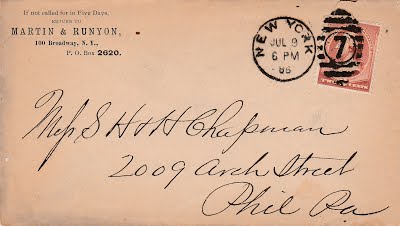
He graduated from the University of the State of New York (AB). He then studied in Polytechnical Schools in Italy, Switzerland and France. He was employed at the Chemist, Bacteriology, and Hygienic Bureau, Paris, France, from 1891-1893.
He graduated from Bellevue Hospital Medical College in 1898 (MD).
In 1916 he patented a foolproof identification film to place on X-Rays to legally identify the person. He worked lifelong as a physician and surgeon.
He was a collector of rare books, documents, letters, and ancient Greek and Roman, Medieval, and Foreign coins from his youth. He was active in historical societies and museums and frequently is cited as a donor.
He purchased a valuable collection of Italian letters from the Maggs Brothers, London, and donated them to Columbia University, Library, New York, together with a collection of rare Italian books valued over $10,000.
He lived at 111 Pierrepont Street, Brooklyn, New York.
He was a member of the New York Numismatic Club. His suggestion to exhibit coins unknown and unclassified was taken up by the NY Numismatic Club and the ANA in 1922.
On December 12, 1922, B. Max Mehl auctioned off his coins in Sale #64, together with H. E. Rawson, and David Strasser Collections.
He owned a rare gold Aureus of Antoninus Pius, a rare gold 1-1/2 Solidi of Constantine the Great of which only about seven were known.
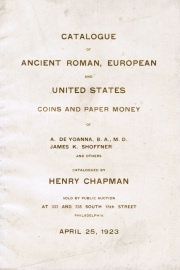 His coin collection combined with that of the late James K. Shoffner of Norristown, together comprising 621 lots that were sold through Henry
Chapman, in his 43rd sale held on Wednesday, April 25, 1923, Davis & Harvey Auctioneers, Philadelphia. Adams rating B-.
His coin collection combined with that of the late James K. Shoffner of Norristown, together comprising 621 lots that were sold through Henry
Chapman, in his 43rd sale held on Wednesday, April 25, 1923, Davis & Harvey Auctioneers, Philadelphia. Adams rating B-.
He died on September 14, 1952, and is buried in Greenwood Cemetery, Kings, New York.
To read the complete article, see:
YOANNA, AURELIUS DE
(https://sites.google.com/a/numismaticmall.com/www/
numismaticmall-com/yoanna-aurelius-de)
The entire inventory of the Lupia Numismatic Library is for sale. Individual items will be available before the remaining archives are broken up into parcels sold at philatelic auctions in the U. S. and Hong Kong. Check NumismaticMall.com frequently as dozens of new items with estimates will be posted daily until everything is sold.
All inquiries will be given prompt and courteous attention. Write to: john@numismaticmall.com .

PHILIPPINE PAPER MONEY RESEARCHER "NIEL" NIELSEN
Howard Daniel submitted this review of the new edition of Ken Berger's book on Philippine currency from the Japanese occupation in World War II. Thanks! It's much more a remembrance of collector and researcher "Niel" Nielsen, hence my headline. -Editor
Philippine Emergency Notes: Counterstamped, Signed & Initialed (CSI), Cebu Province (Second Edition) by Dr. Kenneth J.E. Berger.
 This book is a very important book which fills one of many holes about World War II Philippine Emergency (or Guerilla) paper money. There is a ton of
new information in it compared to the 1st edition and the author was assisted by many numismatists and other people. If you are a collector of these pieces of
paper money you can clearly see the huge amount of work put into it.
This book is a very important book which fills one of many holes about World War II Philippine Emergency (or Guerilla) paper money. There is a ton of
new information in it compared to the 1st edition and the author was assisted by many numismatists and other people. If you are a collector of these pieces of
paper money you can clearly see the huge amount of work put into it.
There is a previous article in The E-Sylum which you can look up online, so I will not repeat what he wrote except to mention that it was made possible by a grant from the Central States Numismatic Society. Good people! There are only 100 copies printed and I have number 32. If you are a collector of paper money, you need to have this catalog in your personal library! Contact the author at csinotes@juno.com or Ray Czahor at cookiejarpi@verizon.net.
I cannot remember the exact date Dr. Berger contacted me in his hunt for photographs of “Niel” Nielsen. Niel apparently did not pose for many pictures and he had passed away on August 10, 2008, so there will be no new ones of him. I did have three pictures in my files and I sent them to the author. He used one of them in the book. After I read about Niel in the book, I decided to write a little here about him because he is still very, very important to the numismatic knowledge known about the Philippines. He was also one of several “old” men who mentored me in how to look at each piece of paper money; research them; and eventually write about them.
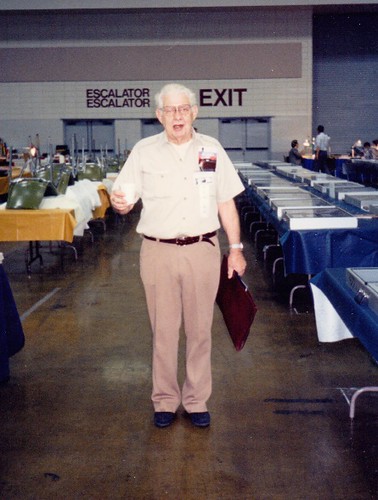

Niel attended every International Paper Money Show in Memphis until he was not physical able to make them. The above left picture shows him walking on the bourse with a coffee cup. It would not be long before he finished for that day looking at the dealers’ inventories and the exhibits, then he headed for the bar. Niel liked his booze and cigarettes. He is carrying a portfolio pouch with many sheets of paper which summarize the many pieces he owns and he could update them if he found something. He often sent photocopies of the summary pages to me and others and it was not often that I could update them. He also often mailed photocopied pages to me from books, paper financial instruments or other things in support of my research of Viet Nam, Lao, Cambodia and the French colonial pieces of those countries.
Several years after the above left picture was taken, he called me in Virginia and told me I was to fly to his Salt Lake City home and bring a checkbook. I knocked on his front door but got a very weak response from inside the house. I walked to the back where sliding glass doors lead into his kitchen. He was sitting at his breakfast table smoking a cigarette and looking at a large stack of “stuff” on it. He waved me into the house. When I opened the door, the strong odor of smoke almost knocked me down. I left the door open. He told me the large stack of books, files, paper money, etc., was for me, but I had to write a check for several thousand dollars to own it. I briefly looked at the stack and wrote him the check.
He told me he wanted to give me a tour of the house. Every room had books and files all over them. Each stack was a research project. In one area was a monster-sized photocopier. He must have paid a lot of money for it! We entered one of the guest bedrooms. He went to the closet and picked up a piece of the floor! Below it was a ladder into the crawl space under the house. Once we were crouched down in the crawl space, he headed toward a room half-buried in the ground. He opened the small door and we went into a vault-like room with boxes full of paper money in serial number sequence. Most of it was a huge collection of WWII Philippine guerrilla paper money! After soaking up most of what was in the room, we went back up to his home office.
After a couple of hours looking at some of his unpublished research papers, I heard knocking on the front door. I opened the door and Bill Henderson, who was an old mutual friend and dealer from Puyallup, Washington, was standing there. Niel had also called him. Bill took the above picture of us sitting at Niel’s desk. Behind Niel’s chair at the breakfast table were two large boxes of Chinese and East Asian paper money with some references and other stuff of interest to Bill. Bill had to write a much larger check than mine but he told me later it was a great buy, as was my stack. Bill has also passed away just in the past year.
Ray Czahor is a specialist in Philippine numismatics. Niel called him much later to come buy everything in the house, which he did. Much of the valuable books and file folders might have gone into a dumpster but Ray saved it and is still putting them in his frequent mail bid sales. With tens of thousands of Philippine guerrilla money, Ray loaned the Cebu notes to Dr. Berger so his greatly expanded 2nd edition could be published. I am hoping Dr. Berger and others will borrow the other notes and write more books about them!
Many collectors and researchers, to include myself, bid on Niel’s paper money, books, files, etc., in Ray’s mail bid sales to add to our personal collections and libraries. It all strongly smelled of Neil’s cigarettes, and I mean strong! But I found a way to take away most of the odor by putting his stuff in a cardboard box with one or two Little Trees with Royal Pine Scent. These are what people hang from their rearview mirrors to cover up odors in their cars. There will always be some smell of his cigarette smoke, but most of it is gone. I believe Niel is very happy that he is being remembered every time we pick up one of his former possessions.
To read the earlier E-Sylum articles, see:
NEW BOOK: PHILIPPINE EMERGENCY NOTES 2ND ED.
(https://www.coinbooks.org/v22/esylum_v22n30a06.html)

Q & A WITH MEDAL RESEARCHER SCOTT MILLER
Jeff Burke submitted this article based on his recent interview with medal researcher and author Scott Miller. Thanks! -Editor


RIGHT: Salmagundi Club medal by Ulysses Ricci
Medal researcher Scott Miller kindly took the time to answer my questions about how he first started to collect coins and medals. I conducted a Q & A interview with Scott through an exchange of e-mails in July 2019. The following information is a synopsis of our exchanges and discussion.
On a personal note, we are delighted to have Scott as a new member of our New Jersey Numismatic Society (NJNS)! I have learned more about medals through our conversations and by seeing Scott’s show-and-tell items at NJNS monthly meetings.
1. Where were you born and raised?
I was born and raised in Brooklyn, NY; I moved to the mainland in 1997.
2. What year did you start collecting coins or medals? Did a grandparent or another figure pique your interest in collecting coins? Can you recall any stories about your early years of collecting?
I am actually not sure when I began to collect. I recall that by the time I was seven or eight (1963), my older brother and I had a small, shared collection. This consisted of a few Whitman folders, Indian Head cents and Barber coins that my father pulled from circulation, and a few silver dollars received as birthday presents from our grandparents. My father, who collected stamps, encouraged collecting and added to my small collection by bringing coins home from his overseas trips.
Soon after starting college in 1972, I was offered a job at Gimbels coin department, where I handled medals for the first time and was soon hooked. One of the other employees took me to the ANS, which was at Audubon Terrace. I asked to see some British medals, and Jeremiah Brady, who was the curator at the time, allowed me to go through the trays of medals provided I checked their attributions.
Once I began to focus on medals, first British commemoratives, and then medals from the Beaux-Arts period, I received help and encouragement from dealers, such as Bob Levin of World Art Medals and Joe Levine of Presidential Coin and Antique Co. I have also been fortunate to have had a good relationship over the years with the ANS and its curators, including Alan Stahl, who invited me to join the Medals Committee. Gordon Frost was another long-time friend who taught me a great deal about books.
Currently, there is no Standing Committee on Medals and Decorations. At one time, the ANS had a number of standing committees that worked with the curators in specific areas. The 1994 Annual Report listed fifteen committees, such as East Asian Coins, Greek Coins, Medals and Decorations, and Medieval and Early Modern Coins. There were also committees for Education, Long Range Planning, and other areas of interest. As of the end of 2018, there were eleven committees, but they are mostly restricted to the Board of Trustees and none appear to relate to specific areas of the collection.
3. You volunteer a few days a week researching and cataloging medals at the ANS. Can you describe how you study and catalog each piece? What have been a few of the highlights from your labor of love at the ANS?
At the moment, I am checking medals against their entries in the MANTIS database, updating information as appropriate. My real interest is in medals from the Beaux-Arts period, an area that has not been well catalogued. I am looking forward to updating the civil war medals, as there are a large number of commemoratives from that period that also need to be researched and catalogued. Old newspapers are a great source of information, and are increasingly easy to use through several on-line sites. I recently started to look at the Society’s Comitia Americana medals, and have already noticed a few things that seem never to have been published.
4. How have medals played a key role in the history of the New York Numismatic Club?
The New York Numismatic Club has been in existence for a bit more than 110 years, and has issued a medal for each club president, as well as a few commemoratives. Having a presidential portrait medal is a great way for the club to get members to commit to the six years of work as Secretary-Treasurer, Vice President, and then President. Besides having a medal struck with my portrait, it is a great feeling to be part of a tradition that included past presidents, such as F.C.C. Boyd, Howland Wood, Edward Newell, and Albert Frey.
5. What suggestions do you have for getting more numismatists involved with studying and collecting medals from the United States and other countries?
One of the great things about collecting medals is the amazing variety of topics and styles of art available. I also found that a lack of specific reference books inspired me to do research, as I try to write books or articles I wanted to read but did not yet exist. It’s also good to know that medals in a couple of specific categories are referred to by Miller numbers.
6. Are you currently engaged in some new and exciting, original research on medals that you could share with readers without revealing too much information?
I am working on an article about the Columbian Anacreontic Society (CAS), a musical Society in New York City from 1795-1803. I first learned about the CAS after seeing the Society’s badge, probably the one from the Yale University Art Museum. It can be found on their website and is part of their numismatic collection. The Columbian Anacreontic Society issued an engraved silver ticket to each member to present at meetings. When a member’s silver admission ticket showed up at auction some years ago, I already knew something about the Society, and that led to additional research. Other projects that are fairly well along include an engraved coin related to someone who was associated with the Lafayette Escadrille, and the 1769 Jubatus Bison medal, which was sold in Amsterdam by J. Schulman in 1930 as part of the Fernand David Collection. I am not aware of any other publication listing this medal, which I now know has a fairly interesting story.
Over the years I put together medal exhibits at Medialia Gallery in New York. The most recent exhibit, which closes this month, is entitled Medallic Images of War: Death and Destruction 1850-1950. It explores how technological and social changes, such as photography, affected images of war on medals.

To read the earlier E-Sylum article, see: COLUMBIAN ANACREONTIC SOCIETY MEMBER'S MEDAL (https://www.coinbooks.org/v20/esylum_v20n42a12.html)
THE BOOK BAZARRE
CHICAGO HALL OF FAME INDUCTS GLENN SMEDLEY
The Chicago Coin Club has announced the eighth inductee into its Hall of Fame. -Editor
Inducts Glenn Smedley Into its Hall of Fame
The Chicago Coin Club announces that the eighth person to be inducted into its Hall of Fame is Victor D. Brenner medal cataloger, author, editor, and hobby leader Glenn B. Smedley. His Hall of Fame citation has been published on the club’s Hall of Fame web page, www.chicagocoinclub.org/projects/hof.
Twelve Hall of Fame inductees have been selected. Each of the remaining four will be announced at the rate of one per month, September through December, during the Chicago Coin Club’s centennial year, 2019.
The Chicago Coin Club was organized in 1912 as American Numismatic Association Branch No. 1, and reorganized under its present name in 1919. All are invited to join. To become a member you must attend a meeting and submit an application along with a membership fee of $20 ($10 for Junior membership). A first reading of your application will be held at this meeting, and a second reading at the next monthly meeting, following publication of your name in the club newsletter. (You are not required to be present for the second reading.) Upon membership approval, you will become a member.
The Chicago Coin Club holds monthly meetings in downtown Chicago, plus at major numismatic conventions such as Central States, with a speaker featured at every meeting except the annual auction, held at the November meeting.
Here is the text of the Glenn B. Smedley entry. -Editor
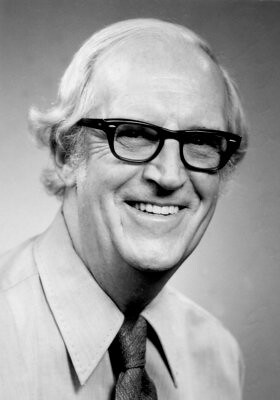 The month after he moved to Chicago from Pekin, Illinois, Glenn B. Smedley joined the Chicago Coin Club as member No. 443, on October 3, 1945. Five
years later he became Secretary-Treasurer for 1950. After serving on many committees, he accepted the position of General Chairman for the 1956 Chicago ANA
Convention. He served as President for the 1960 term, and was the first to receive the Club’s Medal of Merit when it was introduced in 1955. A frequent
exhibitor at meetings, he was also the first to receive a silver Cabeen Exhibit Award, in 1968, and in 1958, the Club’s Literary Award.
The month after he moved to Chicago from Pekin, Illinois, Glenn B. Smedley joined the Chicago Coin Club as member No. 443, on October 3, 1945. Five
years later he became Secretary-Treasurer for 1950. After serving on many committees, he accepted the position of General Chairman for the 1956 Chicago ANA
Convention. He served as President for the 1960 term, and was the first to receive the Club’s Medal of Merit when it was introduced in 1955. A frequent
exhibitor at meetings, he was also the first to receive a silver Cabeen Exhibit Award, in 1968, and in 1958, the Club’s Literary Award.
A self-taught electrician, Mr. Smedley (July 13, 1902 - December 31, 1987) joined Commonwealth Edison Co. in 1924. Three years later he was sent to Mattoon, and two years after that, transferred to Pekin. By 1940 he had been promoted, and was transferred to Chicago in September 1945. He retired in 1964 as a Senior Engineer.
Mr. Smedley began collecting U.S. Type Coins in the 1930s (his first article, in August 1947, offered his definition of the series), supplemented by oddities, but by the mid-1950s he was concentrating on U.S. paper money. Later he added medals to his collection, specializing in the issues of Victor D. Brenner. He was the author of over two dozen articles, plus a monthly column that ran in The Numismatist for 25 years. His most lasting work is his catalog of Brenner medals — the standard reference — published in four parts and reprinted. He also wrote many articles on various aspects of paper money, and was co-editor (with Elston G. Bradfield, Hall of Fame No. 9) of the ANA’s Introduction to Numismatics, 1962 and 1967. He was appointed Assistant to the Editor of The Numismatist in 1959 as Editor Bradfield’s heath declined, becoming Editor with the issue of April 1966 upon Bradfield’s resignation. His last issue was February 1967, after which The Numismatist was transferred to the new ANA Headquarters.
Mr. Smedley served as Chairman of the Central States convention in 1953 and was elected Governor the following year. At the same time, he worked on the ANA Visual Education Committee and was ANA Governor 1953-57, First Vice President 1957-59, and Governor again 1967-77, withdrawing from ANA politics while with The Numismatist editorial office. In 1961 he was co-founder of the Society of Paper Money Collectors, serving as President 1969-71. He moved to Colorado Springs in 1977 to volunteer at ANA Headquarters. Mr. Smedley was a frequent, and award-winning, exhibitor and speaker. In recognition, he received the ANA’s Farran Zerbe Memorial Award, and was inducted into Hall of Fame of both the ANA and the Society of Paper Money Collectors, and the ANA named an award after him.
He was noted for wearing a red golf cap at ANA conventions in the 1960s so that he could be easily identified, perhaps starting as early as 1956 when he was General Chairman. Highly intelligent yet modest and friendly, he was characterized by Numismatist Editor N. Neil Harris as “one of the most principled men I have ever known” and by Ed Reiter “one of the most diligent toilers in the … field.”
I had the pleasure of meeting Mr. Smedley in 1980 when I first visited the headquarters of the American Numismatic Association in Colorado Springs. He kindly gave me a tour of the building and assisted me in the library, all while towing an oxygen tank along beside him. He was indeed a tireless volunteer for the hobby. -Editor
To read the complete article, see:
Glenn B. Smedley (http://www.chicagocoinclub.org/projects/hof/m08.html)
To read the earlier E-Sylum article, see:
CHICAGO HALL OF FAME INDUCTS HARRY X BOOSEL
(https://www.coinbooks.org/v22/esylum_v22n26a21.html)

SPMC 2019 HALL OF FAME INDUCTEES
The Society of Paper Money Collectors (SPMC) inducted four members into its Hall of Fame in 2019. Prior inductees include Matt Rothert, Neil Shafer, and Luis VanBelkum. With permission, here are the bios of the 2019 inductees from the club's web site. -Editor
Frederick Charles Cogswell (F.C.C.) Boyd
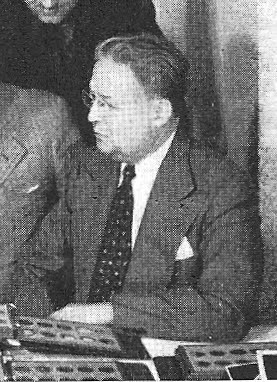 F. C.C. Boyd was born in New York City on April 4 or 10, 1886 and died on September 7, 1958. He is primarily known to the numismatic world today
through the sales of the John J. Ford Collection, the latter having acquired many numismatic items from Boyd. His numismatic interests were far reaching, from
colonials to odd and curious, as well as political ribbons. He was active in the numismatic community and became member # 1594 of the ANA in July, 1912 as well
as a fellow and resident member of the ANS on Jan. 17, 1914. He joined the New York Coin Club in July 1914 and held many offices including President in 1916.
He was prominent on the NYCC paper money committee that resulted in his publication in 1924 of Daniel Valentine's reference book on fractional currency. In
1945 and 1946, Abe Kosoff and his Numismatic Gallery sold portions of the Boyd Collection under the non de plume "World's Greatest Collection."
Among the coins owned by Boyd and his wife Helen, was a 1933 Saint-Gaudens double eagle, which was proudly displayed at two or more ANA conventions.
F. C.C. Boyd was born in New York City on April 4 or 10, 1886 and died on September 7, 1958. He is primarily known to the numismatic world today
through the sales of the John J. Ford Collection, the latter having acquired many numismatic items from Boyd. His numismatic interests were far reaching, from
colonials to odd and curious, as well as political ribbons. He was active in the numismatic community and became member # 1594 of the ANA in July, 1912 as well
as a fellow and resident member of the ANS on Jan. 17, 1914. He joined the New York Coin Club in July 1914 and held many offices including President in 1916.
He was prominent on the NYCC paper money committee that resulted in his publication in 1924 of Daniel Valentine's reference book on fractional currency. In
1945 and 1946, Abe Kosoff and his Numismatic Gallery sold portions of the Boyd Collection under the non de plume "World's Greatest Collection."
Among the coins owned by Boyd and his wife Helen, was a 1933 Saint-Gaudens double eagle, which was proudly displayed at two or more ANA conventions.
Lyn F. Knight
 Lyn Knight has been involved in Numismatics for 56 years staring with very humble beginnings to the present day where he conducts auctions and
operates the annual International Paper Money Show. Lyn grew up in Cherokee Iowa, a nice little community in northwest Iowa. He is considered one of the “Iowa
Boys” when talking about Nationals. He attended his first show when he was 13 years old & set up as a dealer of coin supplies, operating on a budget of
$10.75. He was dependent upon his mother and other dealers to drive him to shows until he got his license.
Lyn Knight has been involved in Numismatics for 56 years staring with very humble beginnings to the present day where he conducts auctions and
operates the annual International Paper Money Show. Lyn grew up in Cherokee Iowa, a nice little community in northwest Iowa. He is considered one of the “Iowa
Boys” when talking about Nationals. He attended his first show when he was 13 years old & set up as a dealer of coin supplies, operating on a budget of
$10.75. He was dependent upon his mother and other dealers to drive him to shows until he got his license.
Like most PM collectors he started out with coins but soon started to appreciate the beauty & rarity of paper money. He states that “He likes building collections for collectors” and while he focusses on paper money & coins, he also likes posters, postcards, art glass and any other good collectable item. He has not strayed far from the Midwest as he lives and conducts his business in the Kansas City area. Lyn worked for a few different coin businesses in the beginning, but Lyn prefers to be independent (and he readily acknowledges the assistance his has from his wife & son). His auction business has conducted PM sales for over 30 years with many being tied in with the major shows.
Lyn has had the pleasure of working with some of the most recognized names in the hobby. Probably the most famous one was Amon Carter. Lyn had the pleasure of selling his collection that contained so many great rarities. Lyn has also been involved with liquidation of Bank cash holdings over the years. He has always been fair & honest in his dealings as a dealer, auctioneer & a show promoter. Being inducted into the Hall of Fame recognizes Lyn’s long time contributions and promotion of our great hobby.
James Roy Pennell, JR
 Pennell was born on May 29, 1924 and passed away on June 17, 2008. Mr. Pennell received a Bachelor of Science Degree in Civil Engineering from
Clemson University and was a graduate of the Harvard Business School (1973 - 1975). He served in the United States Naval Reserve during World War II and the
Korean Conflict. His highest rank achieved was Lieutenant of the Civil Engineering Corp. He was a member of the United States Assay Commission (Presidential
Appointment on February 12, 1969) and a member of the South Carolina State Museum Board.
Pennell was born on May 29, 1924 and passed away on June 17, 2008. Mr. Pennell received a Bachelor of Science Degree in Civil Engineering from
Clemson University and was a graduate of the Harvard Business School (1973 - 1975). He served in the United States Naval Reserve during World War II and the
Korean Conflict. His highest rank achieved was Lieutenant of the Civil Engineering Corp. He was a member of the United States Assay Commission (Presidential
Appointment on February 12, 1969) and a member of the South Carolina State Museum Board.
He was a charter member of the SPMC and held member #8 as well as Honorary Member # 9 and Honorary Life Member #8. He served as President of the SPMC from 1971-1975; vice president 1969-1971; secretary from 1964-1967 and governor from 1965-1979. He received an Outstanding Service Award in 1968 and the Nathan Gold award in 1988. In 1985, he wrote a reference book on North Carolina obsoletes, Obsolete Banknotes of North Carolina, published by Sanford Durst. Mr. Pennell was honored by a special exhibition in the Smithsonian. He joined the ANA in 1945, was a Fellow of the American Numismatic Society.
Austin Sheheen, JR
 A long time collector of South Carolina paper (notes, stocks, bonds, etc), Mr. Sheheen holds SPMC member #2207 and Life Member #122. He served the
society as President from 1991-1993; vice-president 1989-1991 and governor from 1988-1992. He published South Carolina Obsolete Notes in 1960 and did a
major revision South Carolina Obsolete Notes and Scrip in 2003.
A long time collector of South Carolina paper (notes, stocks, bonds, etc), Mr. Sheheen holds SPMC member #2207 and Life Member #122. He served the
society as President from 1991-1993; vice-president 1989-1991 and governor from 1988-1992. He published South Carolina Obsolete Notes in 1960 and did a
major revision South Carolina Obsolete Notes and Scrip in 2003.
To read the complete article, see:
Hall of Fame (https://www.spmc.org/hall-of-fame)
For more information about The Society of Paper Money Collectors (SPMC), see:
https://www.spmc.org/
WHEN INSTITUTIONS FAIL: PART II
The May/June issue of Paper Money, the official publication of the Society of Paper Money Collectors contained the first of a two-part series of articles by Loren Gatch titled "When Institutions Fail". With permission, we're republishing Part II here - it was published in the July/August 2019 issue. Yeah, I added another meme. -Editor
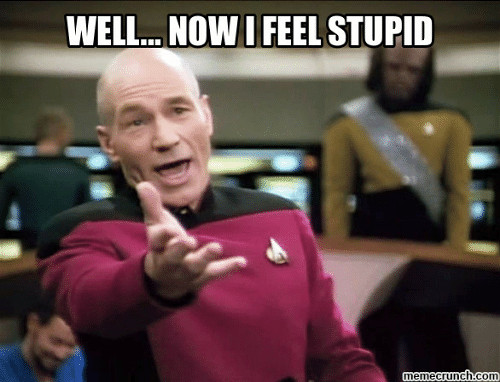 Catalogs and other reference works are essential institutions of numismatics. In my previous column I used the bankruptcy of F+W Media, a major
publisher of numismatic works, as an opportunity to explore how their disappearance might harm collectors and students of numismatics alike. Earlier this year,
the sudden demise of PCGS Currency, a major Third Party Grader (TPG) of banknotes, has raised similar issues.
Catalogs and other reference works are essential institutions of numismatics. In my previous column I used the bankruptcy of F+W Media, a major
publisher of numismatic works, as an opportunity to explore how their disappearance might harm collectors and students of numismatics alike. Earlier this year,
the sudden demise of PCGS Currency, a major Third Party Grader (TPG) of banknotes, has raised similar issues.
In some ways, the travails of PCGS Currency are more interesting because TPGs are a relatively new feature in the field of numismatics. First established during the 1970s for coins, their activities spread later to encompass banknotes and currency. TPGs do a number of important things. First and foremost, they arbitrate the inevitable disputes between buyers and sellers over what grade to give a coin or note. Second, TPGs authenticate the material they grade, especially for high-value items. Third, and related to the first two services, TPGs help with attribution by labeling the materials they grade, according to catalog number, variety, and provenance. Fourth and finally, they seal the coin or note in a tamper-resistant holder, ensuring that all that information—grade, authentication, and attribution—corresponds to the correct item.
TPGs do these things for a fee, and millions of dollars have been spent getting various collectibles “holdered” or “slabbed”. Critics of this argue that collectors ought to develop the expertise to judge their own material. Also, by encouraging people to buy the grade, not the note, TPGs tend to commodify the hobby, contributing to cost escalations across small differences at the highest grades. While I have some sympathy for these views, I think they ignore the real value such services provide. Much as even sophisticated investors consult rating agencies like Moody’s to tell them how risky bonds are, collectors can rely on TPGs’ assessments before they commit to buy.
But it’s not enough for a TPG to grade an item and be done with it. The service presumes that the TPG stays in business to offer follow-up benefits like cert verification, population reports, and registry sets. Above all, the confidence collectors have in the grade may depend on the sheer persistence of the company that bestowed the grade in the first place. It would seem that, if a grading company were to disappear, that shouldn’t affect the validity of the judgments it made about the coins and notes that it graded. Those judgments are independent of the existence of the company that made them. But what if they aren’t independent?
At the end of last January, we experienced a test of this proposition when PCGS Currency suddenly shut down its operations. In the United States, currency grading under the PCGS label was done not by Collectors Universe, Inc., the owner of that brand, but by another party, K3B, Inc., who had licensed the PCGS name. For reasons that are unclear, that agreement was not renewed and the PCGS Currency website went dark. This event flummoxed currency collectors and dealers alike. In the short run. what would become of all those notes in transit, or otherwise in the process of grading? In the medium term, how would collectors access cert verifications to confirm information about holdered notes? What would become of the online set registries that collectors assemble with pride? And over the long haul, what would happen to the trust that the numismatic market accords to PCGS grades, if PCGS Currency itself were no longer in business? Paper Money Grading (PMG) a competitor, was quick to offer a crossover service to owners of PCGS-graded notes to take advantage of that fear.
Since PCGS Currency’s closure, the individuals behind it have re-invented themselves as Legacy Currency Grading, Inc. promising to maintain continuity with all the benefits provided by their predecessor. This may, or may not, succeed. However, this episode raises questions not just about PCGS-graded notes, but about the long-term viability of professional grading itself. This is a real issue, given the vast sums people spend on third-party certification. In contrast, the cost of any single catalog represents a minor, one-time expense for a collector. As F+W Media shows, no catalog publisher lasts forever. Neither, for that matter, will grading companies. Will collectors really tolerate the expense of repeatedly having the grades bestowed by some defunct TPG recertified by its successor? That would not seem reasonable to me.
Maybe forty years from now, none of these TPGs will exist. By then, our grandchildren will be happily collecting holograms of their favorite notes, certified on the blockchain, while the original objects will be sequestered permanently in vaults, protected against the ravages of climate change. And looking back, maybe those grandchildren will wonder why we foolishly wasted millions of dollars paying for encapsulated opinions that weren’t designed to stand the test of time.
To read the earlier E-Sylum article, see:
WHEN INSTITUTIONS FAIL: PART I (https://www.coinbooks.org/v22/esylum_v22n22a22.html)
For more information about The Society of Paper Money Collectors (SPMC), see:
https://www.spmc.org/

MINT SELECTS 27 ARTISTIC INFUSION PROGRAM ARTISTS
This U.S. Mint press release came out July 17, 2019 with information about the latest members of the Artistic Infusion Program (AIP). -Editor

Today, the United States Mint (Mint) announced that 27 artists have been selected to participate in its Artistic Infusion Program (AIP) to enrich and enhance designs on U.S. coins.
“We’ve selected diverse artists who represent every region of America, from coast to coast,” said Mint Director David J. Ryder. “Sixteen of the artists are new to the program and we’re challenging them to exert a major influence on the future of our nation’s coinage, to aspire to the creative mastery of giants such as Augustus Saint-Gaudens, Victor David Brenner, and A.A. Weinman as the Mint creates new designs in the 21st century.”
AIP artists were selected based on the artistic merit of their applications and demonstration designs they submitted during a national Call for Artists. All the AIP artists selected attended a three-day symposium from June 3 to June 5, 2019, featuring intensive training to welcome, guide and inspire their work. AIP artists who took honors in the 2019 Coin of the Year Awards – Justin Kunz and Chris Costello for the 2017 American Liberty 225th Anniversary Gold Coin as Best Gold Coin, and Emily Damstra for the Boys Town Centennial Silver Dollar, as Most Inspirational Coin – were also recognized at the symposium with a commemorative plaque signed by the Director of the Mint.
Below is a list of the artists selected for the Artistic Infusion Program.
To save space, instead of a table I'll list the names here: Katelyn Arquette, Peter Beck, Robert J. Clarke, Chris Costello, Emily Damstra, Allen Douglas, Lucas Durham, Don Everhart, Steve Ferris, Barbara Fox, Dennis Friel, Elana Hagler, Christina Hess, Tom Hipschen, Steven Kenny, Justin Kunz, Patricia Lucas-Morris, Richard Masters, Frank Morris, Laurie Musser, Jennie Norris, Ron Sanders, Ben Sowards, Matt Swaim, Heidi Wastweet, Donna Weaver and Beth Zaiken.
There are many familiar names here, including former Mint personnel Don Everhart and Donna Weaver, former Citizen's Coinage Advisory Committee member Heidi Wastweet, and former Bureau of Engraving and Printing artist Tom Hipschen.
I spent some time looking up some of the new artists. Some are fine artists or graphic designers who haven't done coin or medal designs before (first time for everything, though)! Good luck, all. We;ll look forward to collecting your work. -Editor
The AIP was established in 2003. It serves to enrich and invigorate the design of United States coins and medals by developing a pool of outside artists who specialize in graphic design, sculpture, engraving, drawing, painting, and other visual arts. These artists work closely with the United States Mint’s staff, including Sculptor-Engravers, to create and submit new designs for selected coin and medal programs throughout the year.
The designs of AIP artists adorn many United States coins and medals, such as America the Beautiful Quarters®, Native American $1 coins, commemorative coins, platinum proof coins, Congressional Gold Medals, American Liberty gold coins, and various silver and bronze medals.
Artists who join the AIP work under a task order contract from their own studios across the country, providing candidate designs in the form of finished drawings. Artists are paid $2,000 to $3,000 per assignment and are awarded a $5,000 bonus if their design is selected for a coin or medal by the Secretary of the Treasury. In addition to the bonus, the artist is named in historical documents, Certificates of Authenticity, and promotional materials. In most cases, the artist’s initials appear on the final coins or medals along with the initials of the Sculptor-Engraver who sculpted the selected design.
To read the complete press release, see:
United States Mint Selects 27 Artists
for Artistic Infusion Program (https://www.usmint.gov/news/press-releases/united-states-mint-selects-27-artists-for-artistic-infusion-program)
For more information about the artists, see: https://www.usmint.gov/learn/artists
EMILY DAMSTRA'S MARY GOLDA ROSS COIN DESIGN
An article by Herman Viola in the Winter 2018 issue of American Indian profiles NASA engineer Mary Golda Ross and discusses the 2019 $1 coin honoring Ross designed by the Mint's Artistic Infusion Program artist Emily Damstra. Here's an excerpt. I added an image of the coin design. -Editor
 The earth-bound achievements of Mary Ross will be the centerpiece in early 2019 of a new coin honoring American Indians in the Space Program. Each
year since 2009, the United States Mint has produced and issued a $1 coin that celebrates significant contributions Indian tribes and persons have made to the
history and development of the United States. Ross will represent both her own work and that of several other prominent Indians, such as astronaut John
Herrington (Chickasaw) and flight controller Jerry C. Elliott High Eagle (Osage/Cherokee). Herrington manned the International Space Station in 2002. Elliott
plotted the re-entry of the troubled Apollo 13 mission and received a Presidential Medal of Freedom for his role in saving the astronauts.
The earth-bound achievements of Mary Ross will be the centerpiece in early 2019 of a new coin honoring American Indians in the Space Program. Each
year since 2009, the United States Mint has produced and issued a $1 coin that celebrates significant contributions Indian tribes and persons have made to the
history and development of the United States. Ross will represent both her own work and that of several other prominent Indians, such as astronaut John
Herrington (Chickasaw) and flight controller Jerry C. Elliott High Eagle (Osage/Cherokee). Herrington manned the International Space Station in 2002. Elliott
plotted the re-entry of the troubled Apollo 13 mission and received a Presidential Medal of Freedom for his role in saving the astronauts.
The Ross proposal, like many of the Native American $1 coins, started as a narrative provided by and design concepts developed in consultation with the National Museum of the American Indian. The Native American $1 Coin Act requires consultation with the Committee on Indian Affairs of the Senate, the Congressional Native American Caucus of the House of Representatives, and the National Congress of American Indians. Once the design concepts are defined, the Citizens Coinage Advisory Committee (CCAC) discusses them during its public meetings.
Emily Damstra, an American freelance science illustrator living in Guelph, Ont., was selected to create the design for the 2019 coin.
She explains, “I first learned about Mary Golda Ross upon receiving the assignment to design this coin celebrating the contributions of American Indians to the United States space program. Her achievements deeply impressed me, and I was excited for the opportunity to tell her story through numismatic art. From the beginning of my design process, before I had anything else worked out, I knew that my design would include a figure of her.” Damstra’s only regret is that she could not fit in a feather into her design.
A figure representing American Indian astronauts is included, she says, because, “I knew Ross was not the only American Indian who contributed to the space program. Though we don’t see his face, the astronaut in my design is outfitted as John Herrington would have been for extravehicular activity. I liked the idea of including an astronaut in space because such a feat was ultimately made possible by the work of people like Mary Golda Ross.
“I came up with the general design elements pretty quickly,” she admits, “but the details and configuration went through several iterations before being finalized. For example, I originally drew Ross using a Friden calculating machine, but it looked too much like a typewriter so I replaced it with paper, a pencil and a slide rule. Ross undoubtedly employed these tools while working on the Agena rocket program at Lockheed Martin. The small tools may not be obvious at coin size, but their purpose is evident in the large equation inscribed across the Atlas-Agena rocket exhaust behind Ross. I’m very grateful to NASA for providing that equation.”
To read the complete article, see:
Mary Golda Ross: She Reached for the Stars
(https://www.americanindianmagazine.org/story/mary-golda-ross-she-reached-stars)
See also:
Honoring the contributions of Native Americans to the U.S.
Space Program (https://emilydamstra.com/news/honoring-contributions-native-americans-u-s-space-program/)

NUMISMAGRAM MEDAL SELECTIONS: AUGUST 2019
Jeremy Bostwick of Numismagram forwarded these interesting selections from his August upload of new medallic art to his website. In addition to the highlights below, one will notice a particular focus upon aviation-themed medals, an array of artistic nude medals and plaques (drawing upon Neo-Classical, Art Deco, and even modern art styles), and a small group of higher grade World War I-related pieces. Please visit numismagram.com/inventory for all of the new items. -Editor
Amundsen & Ellsworth silvered bronze Medal

100668 | NORWAY & UNITED STATES. Roald Amundsen & Lincoln Ellsworth silvered bronze Medal. Issued 1925. Commemorating the northernmost latitude attained by air at that time (72mm, 167.27 g, 12h). By C. Pillet in Paris. Amundsen and Ellsworth placing Norwegian flag upon ice floe; 88º NORD to lower left / AMUNDSEN–ELLSWORTHS • POLFLYVNING • 1925, the Dornier Do J N-25 flying right over cracked ice. Edge: «triangle containing JtB» BRONZE. Joos a.462. Choice About Uncirculated. Pleasing matte surfaces with some scattered marks and scuffs. An extremely rare aviation type, especially in silvered bronze. Ex Michael Joos Collection. $595.
The accomplished explorer Roald Amundsen, having led the first expedition to traverse the Northwest Passage in 1906 and to reach the South Pole in 1911, set out to reach the North Pole in 1925. Accompanied by American Lincoln Ellsworth and four others, Amundsen first attempted to reach the North Pole by air in two Dornier Do J flying boats, the N-24 and N-25. The expedition reached 87º 44' N before landing each plane a few miles apart. In the process, the N-24 was damaged, and required over 3 weeks of repairs, with the crew nearly depleting their rations. The repairs complete, the pair of planes successfully took off and returned to their home base.
The following year, Amundsen led another expedition, this time able to fly over the North Pole in the airship Norge, becoming the first of two men (Oscar Wisting being the other) to reach both geographic poles of the earth. Richard E. Byrd had reached the North Pole by air three days prior, but this feat his long been disputed as Byrd's journal entries appear to have been altered and his actual accomplishment in doubt. This medal commemorates Amundsen's 1925 expedition—though not successful in reaching the North Pole fully, it represented the further north which a journey had reached by air at that time.
An excellent medal, quite spare and desolate like the pole itself. -Editor
To read the complete item description, see:
100668 | NORWAY & UNITED STATES. Amundsen & Ellsworth silvered bronze Medal.
(https://www.numismagram.com/product-page/100668)
Richard E. Byrd Bronze Medal
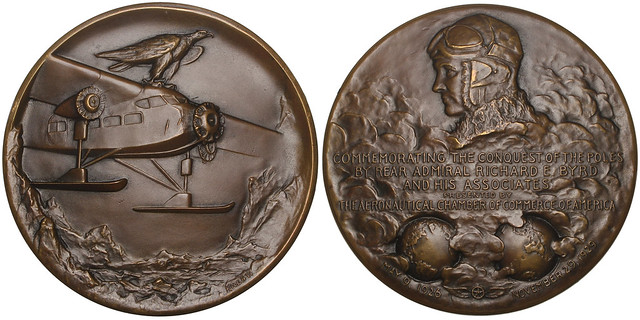
100669 | UNITED STATES. Richard E. Byrd bronze Medal. Issued 1929. Commemorating his (alleged) feat of being the first to reach both the North and South Poles by air (82mm, 206.31 g, 12h). By J. Kilényi and struck by Whitehead-Hoag. Ford trimotor flying right, surmounted by eagle perching right / Head of Byrd left, wearing aviator hat and among the clouds; in five lines below, COMMEMORATING THE CONQUEST OF THE POLES / BY REAR ADMIRAL RICHARD E. BYRD / AND HIS ASSOCIATES / PRESENTED BY / THE AERONAUTICAL CHAMBER OF COMMERCE OF AMERICA; below, two globes featuring the North and South Poles, respectively. Edge: WHITEHEAD-HOAG, light stain. Joos a.635; Marqusee 217. Choice Mint State. Satin brown surfaces. Very rare aviation type. Ex Michael Joos Collection. $795.
One of the most decorated airmen in American history, Richard E. Byrd claimed to have been the first man to reach both of earth's geographic poles by air, but the account of his reaching the North Pole has long since been in doubt. Setting out from Spitsbergen in the Josephine Ford (a Fokker F.VIIa/3m monoplane), Byrd and his co-pilot, Floyd Bennett, allegedly completed their goal in a 15+ hour roundtrip on 9 May 1926. A few days later, fellow explorer Roald Amundsen would reach the North Pole by air with his crew aboard the airship Norge. Byrd returned to the United States a national hero, but doubts began to emerge, as Bennett's apparent confession to a fellow aviator, Bernt Balchen, revealed that they had not, in fact, fully reached the North Pole. Released in 1996, Byrd's journal entries revealed erased coordinates that would belie the claim that the journey was successful. Nevertheless, when Byrd reached the South Pole in 1929, even more fanfare followed as, in the minds of many, he had become the first to reach both poles by air—the cause for the issue of this medal.
Interesting medal, if dubious history. I especially like the obverse. -Editor
To read the complete item description, see:
100669 | UNITED STATES. Richard E. Byrd bronze Medal.
(https://www.numismagram.com/product-page/100669)
Leda and the Swan Plaque
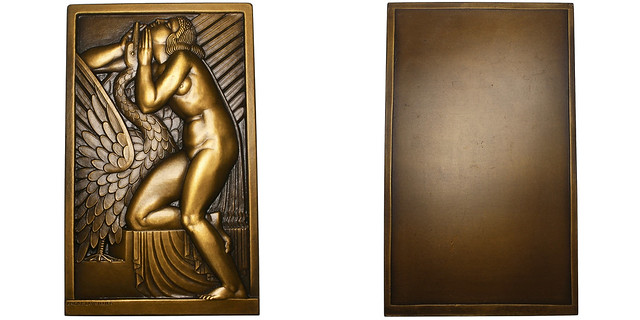
100739 | FRANCE. Art Deco uniface bronze Plaque. Issued circa 1922. "Lèda et le Cygne" (61x100mm, 282.14 g). By A. H. Lavrillier. Leda left, with knee set upon draped base, being seduced by swan to left / Blank. Edge: «cornucopia» BRONZE. Maier 313. Gem Mint State. Brilliant bronze surfaces, with a charming antiqued nature. An exceptional and classical Art Deco design. $595.
An iconic mythological scene represented since antiquity in various sculptures and paintings, Lavrillier has portrayed it here in the Art Deco form of his time. It portrays a wondrous, erotic dance between Leda (a mortal) and a swan (Zeus, the king of the gods, in disguise).
Unusual subject - a great Art Deco medal. -Editor
To read the complete item description, see:
100739 | FRANCE. "Lèda et le Cygne" uniface bronze Plaque.
(https://www.numismagram.com/product-page/100739)
Boston Whist Gaming Counters

100740 | GERMANY. Set of four silver Jetons or Gaming Counters for Boston Whist. Issued circa 1840. By Loos in Berlin.
1). (26mm, 5.57 g, 12h). ICH FORDERE (I bid [the trick]), gentleman seated left at table, with grip of cards and playing an A♤ / SIMPLE; 5•6•7/8•9 above, alternating groups of three and four pellets below. Edge: Plain. Hasselmann 0393 var. (brass).
2). (26mm, 5.53 g, 12h). SIE MACHEN FARBE (you reveal the trump), gentleman seated right at table, laying down his grip of cards / DOUBLE; 3•4• above, group of three and four pellets below. Edge: Plain. Hasselmann 0392 var. (same).
3). (26mm, 5.51 g, 12h). ICH LACHIRE (I send a signal), gentleman seated left at table, revealing his grip of cards to us / TRIPLE; 1•2 above, one and two pellets below. Edge: Plain. Hasselmann 0391 var. (same).
4). (26mm, 5.51 g, 12h). ICH INVITIRE (I invite [you to follow suit]), gentleman seated right at table, with grip of cards and playing uncertain card, possibly a 3♧. Edge: Plain. Hasselmann 0394 var. (same).
All pieces: Mint State. Highly prooflike, with some scattered hairlines and a few spots. Includes metal case. Very rare and interesting piece of gaming history, especially so attractive and with original case. Compare to a similar set, though struck in tin-silver, with more contact marks and rub, and without the case, which realized just under $300 (after buyer's fee) in Höhn 77 (19 April 2013), lot 338. $295.
Whist is a trick-taking game played in pairs and with a standard "French-style" 52 card deck, immensely popular in the 18th and 19th centuries. Countless varieties on the standard game exist, one of which is "Boston" whist, which was played in the west outside of Great Britain and involves an element of bidding to further augment skill in gameplay. Due to the nature of scoring, some form of notation was required, and tokens provided a popular means. The various reverses of the present pieces display the point scenarios, while depicting jovial aspects of the game on their obverses. Additionally, containers for the pieces were also produced, allowing the owner to conveniently bring their tokens to the table for use. These sets represent a 19th century analog to a contemporary chip set brought for a spirited night of gameplay.
An interesting and unusual group. -Editor
To read the complete item description, see:
100740 | GERMANY. Set of 4 silver Jetons or Gaming Counters for Boston Whist.
(https://www.numismagram.com/product-page/100740)

THE PASIG RIVER COLLECTION
Jeremy Bostwick recently joined Stack's Bowers as a Senior Numismatist & Cataloger. He's already published some great blog posts; here's his latest on coins and medals in the Pasig River Collection. -Editor

The Pasig River Collection features some of the most stunning examples of Filipino coins assembled, with many being the finest certified. This array of denominations and dates will undoubtedly present an important opportunity for the connoisseur to acquire pieces unlikely to be rivaled anytime soon. Some of these exceptional offerings include a trio of Pesos (1907-S, 1909-S, and 1911-S; lots 21509, 21512, and 21515, respectively), all spectacularly toned gems with incredible eye appeal. Of particular note is an absolute key to the series—a stunning mint error whereby a 5 Centavos was muled with a 1918-S 20 Centavos reverse die (lot 21545). Owing to their similarity in size, the error itself went unnoticed for years, resulting in many examples seeing their fair share of circulation. The gem from this collection will assuredly become the centerpiece of one of the finest Filipino cabinets. Additionally, numerous early proof sets featuring an array of Gem and plus Gem examples are offered; these are very seldom encountered so majestic.
Throughout this series of coinage, the influence of the United States is on full display, rather overtly, on the reverses of the various denominations, as the coat-of-arms contains an eagle, with wings fully spread, atop a shield adorned with the American stars and stripes. Additionally, the Philadelphia and San Francisco mints produced the majority of Filipino coinage. In this way, reminders of colonialism remained long after the previous power, Spain, was defeated.
In 1941, following the Japanese attack on Pearl Harbor in Hawaii, the invasion of the Philippines began. History was seemingly repeating itself, with the Japanese now ousting the Americans in power, leading to a surrender and subsequent Japanese occupation for the next three years. During this period of strife, the Pasig River Collection tells the story not through coins, but rather through medals. One such type is the "Homma" medal, so named for General Masaharu Homma, the Commander-in-Chief of the Japanese Armed Forces who oversaw the fall of Bataan and Corregidor. Lot 21571, an exceptional near choice piece, is undoubtedly one of the finest, and is followed by three additional versions of the type (lots 21572-21574).
Another interesting medal recounts the Japanese air attack on the Philippines (lot 21576) by Battalion 9936, a very rare piece in such a pleasing state of preservation. Additional medals issued for the aforementioned Bataan campaign—infamous for the grueling Bataan Death March—include lots 21582-21584, all rare and historically important pieces. During the occupation, a puppet state was created, with Jose P. Laurel installed as president. Though this served as little more than sanitization for Japanese domination, medals also recount this brief period, such as lot 21586—a very rare and attractive piece featuring the "president's" bust and a national flag, this despite there being no actual aspects of democracy or republicanism.
Following the bombing of Hiroshima and Nagasaki, the war in the eastern theater was finally brought to a swift end and, with it, the Japanese occupation of the Philippines. Less than a year later, the Philippines finally achieved the freedom and self-rule that had long been sought, 425 years after Magellan's exploration brought with it the subjugation of outsiders.
Here are a few medal lots that caught my eye. I'd never seen any of these before. -Editor


PHILIPPINES. Japanese Occupation. Silver Homma Medal, ND (1942). By: C. Zamora. PCGS MS-62 Gold Shield.
Struck to commemorate the fall of Bataan and Corregidor by General Masaharu Homma, the Commander-in-Chief of the Japanese Armed Forces. Obverse: Japanese soldier in combat gear facing away at center, gazing at the hills of Bataan and island of Corregidor in background; Reverse: Two palm trees, stars in middle, Japanese characters throughout field. The Japanese characters are a poem to pay tribute to soldiers who died in combat and credits General Masaharu Homma in writing.
To read the complete lot description, see:
PHILIPPINES.
Japanese Occupation. Silver Homma Medal, ND (1942). By: C. Zamora.
(https://auctions.stacksbowers.com/lots/view/3-J6BDP/philippines-japanese-occupation-silver-homma-medal-nd-1942-by-c-zamora-pcgs-ms-62-gold-shield)

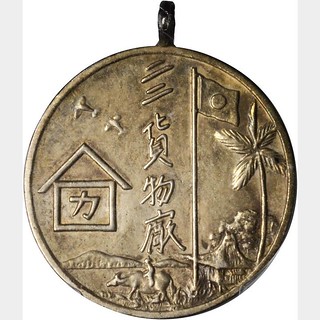
PHILIPPINES. Japanese Occupation. Silver Surrender of Bataan/Quartermaster Medal Mule, 1942. By: C. Zamora. PCGS MS-61 Gold Shield.
Honeycutt-319/315; Basso-159/153. Obverse: Scene of Bataan with Japanese flag, "SOUVENIR" above, date of "APR 9, 1942" below flag; Reverse: Island view of Philippines with Japanese flag on flagpole, vertical line of Japanese characters left, Japanese symbol within house, Japanese Zero's above. An EXTREMELY RARE issue combining a souvenir medal and commemorative medal.
To read the complete lot description, see:
PHILIPPINES. Japanese Occupation. Silver Surrender of Bataan/Quartermaster Medal Mule, 1942. By: C. Zamora.
(https://auctions.stacksbowers.com/lots/view/3-J6BAO/philippines-japanese-occupation-silver-surrender-of-bataanquartermaster-medal-mule-1942-by-c-zamora-pcgs-ms-61-gold-shield)
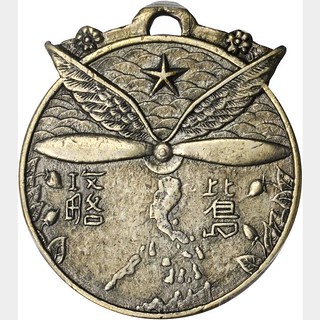
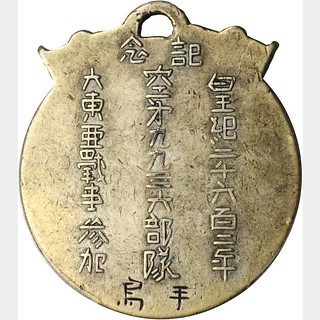
PHILIPPINES. Japanese Occupation. Silver Air Attack on the Philippines Medal, 2602 (1942). PCGS EF-45 Gold Shield.
Honeycutt-314; Basso-152. VERY RARE especially so in this state of preservation. Struck to commemorate the participation of the Air Force Battalion 9936 during World War II in 1942. Obverse: Wings attached with propeller, map of Philippines below; Reverse: Three vertical lines of Japanese characters, name inscribed in Japanese at bottom. A well made example with golden-grey patina throughout. A highly sought after and seldom offered medal destine for an advanced collection.
To read the complete lot description, see:
PHILIPPINES. Japanese Occupation. Silver Air Attack on the Philippines Medal, 2602 (1942).
(https://auctions.stacksbowers.com/lots/view/3-J6BBN/philippines-japanese-occupation-silver-air-attack-on-the-philippines-medal-2602-1942-pcgs-ef-45-gold-shield)
To read the complete article, see:
The Yoke of Domination: Filipino Numismatics from the Pasig
River Collection (https://www.stacksbowers.com/News/Pages/Blogs.aspx?ArticleID=pasig-river-collection-ana)
JOSEPH MICKLEY MEMORIAL MEDAL AND ARCHIVE
One lot which caught my eye in the upcoming Stack's Bowers Rarities Night sale features a rare medal of Philadelphia numismatist Joseph J. Mickley along with catalogs and other publications relating to Mickley and his collection. Here's an excerpt - see the complete lot online. A great opportunity for numismatic bibliophiles. -Editor
Lot 5059: Joseph J. Mickley Birth and Death Memorial Medal


"1878" (1879) Joseph J. Mickley Birth and Death Memorial Medal. Silver. 50.8 mm. 74.3 grams. By Lea Ahlborn. Mint State, Edge Bumps. Obv: Bust of the famous numismatist right with the inscriptions JOSEPH J. MICKLEY PRES. SOCIET. NUMISM. ANTIQU. PHILADELPHIE around the periphery and, in smaller letters, NAT. 1799 OB. 1878. at the lower border. Signed by the artist under the bust LEA AHLBORN FEC. Rev: Thick wreath surrounds the inscription STAT SINE MORTE / DECUS.
This medal was designed by Lea Ahlborn of Stockholm and struck in the Swedish Mint in early 1879 under the supervision of Henry J. Mickley. Examples were sold to contemporary collectors through dealer S.K. Harzfeld. It was expected that just about every numismatist at the time would desire an example, but sales proved slow, and today the medals are elusive. Indeed, this is the first specimen that we can recall handling since our (Bowers and Merena's) May 1999 sale of the Harry W. Bass, Jr. Collection, Part I, which included Mr. Bass' specimen as lot 2122.
Joseph J. Mickley's diary written in 1870, during a trip to Sweden, included this for Tuesday, July 26:
"Visited the Mint. It was not in operation; the mintmaster Ackermann, who was very friendly, went through the establishment with me to show me all the different parts. I saw nothing different from anything I had seen in the machinery of other mints I visited, except a machine for planing the planchets, to give them the proper weight. But the most remarkable about it is that the person engraving the dies is a lady, Mrs. Lea Ahlborn, 44 years of age. He taught her modeling and engraving, when he found she had a talent for it. She presented me with two medals, one for the Mint Cabinet, and the other for myself. She is a very pleasant and amiable lady; speaks German fluently. She has a sister who is a very good wood engraver."
Here are the literature items included in the lot. -Editor


Joseph J. Mickley, Dates of United States Coins and Their Degrees of Rarity, Philadelphia, 1858, (4) pages hardbound in a modern glossy black cloth cover with extra leaves added for bulk. One-inch tear at the head of the first page, else a Fine and unmarked copy. This is Mickley's only published numismatic title. From our (Bowers and Merena's) sale of the Armand Champa Library, Part I November 1994, lot 413. Lot tag included.
W. Elliott Woodward, Fine Paper copy, Catalogue of the Numismatic Collection formed by Joseph J. Mickley, Esq. of Philadelphia, Now the Property of W. Elliott Woodward of Roxbury, Mass., October 28, 1867 and the five following evenings, 196 pages, 3,349 lots, hand-priced in black ink, contemporary black half calf, marbled boards, portion of original front wrapper mount on front board, binding scuffed but tight, tear to the bottom of page 103, others with light discoloration and minor creases, but the whole a pleasing Very Good. Mickley's 1804 silver dollar is lot 1696 in this catalog, at the top of page 99. One of the rarest W.E. Woodward special edition catalogues with no more than three copies known. Ex numismatic book collection of the Wadsworth Athenaeum in Hartford, Connecticut; our (Bowers and Merena's) sale of the Armand Champa Library, Part III, September 1995, lot 2681.
(compiled by) Minnie F. Mickley, The Genealogy of the Mickley Family of America, originally published by the Mickleys, Pennsylvania, 1893, this undated modern reproduction published by Tuttle Antiquarian Books, Rutland, Vermont, 183 pages, softbound in brown covers, binding and pages tight and clean, a neatly made and well preserved reproduction, As New.
To read the complete lot description, see:
"1878" (1879) Joseph J. Mickley Birth and Death Memorial Medal, accompanied by a treasure trove of literature pertaining to the renowned...
(https://auctions.stacksbowers.com/lots/view/3-J3ZFK/1878-1879-joseph-j-mickley-birth-and-death-memorial-medal-accompanied-by-a-treasure-trove-of-literature-pertaining-to-the-renowned)
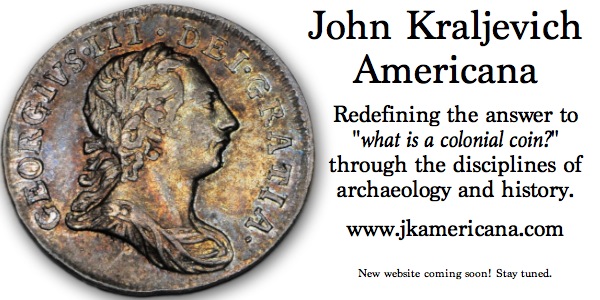
2019 WORLD'S FAIR OF MONEY EXHIBIT AREA
Also on tap for the upcoming ANA event near Chicago is the exhibit area. Paul Hybert submitted this note. Thanks. -Editor
An online guide to the Collector Exhibit Area at the 2019 World's Fair of Money is available online at:
http://www.chicagocoinclub.org/events/2019/ana/ex/all_by_cl.html
Visit this page before you arrive at the convention center to determine your must-see exhibits, or visit this page to help you remember that exhibit you want to see again! This page will be updated during the convention, to list just the exhibits which are present. The Collector Exhibit Area is on the bourse floor, far to the left as you enter.
Note that Class 17 "Numismatic literature" has two planned entries: "Buy The Book For The Coin" and "The Numismatic Literature of Napoleonic Medals". Check them out at the show, along with all the other great exhibits. -Editor
MEDIEVAL VENETIAN SILVER COIN FIND
Found via The Explorator newsletter is this article on some medieval silver coins recently discovered in Bulgaria. -Editor

A total of three silver coins minted in the medieval Republic of Venice, an Italian city-state that was a major power in the Mediterranean, have been discovered in very good condition by archaeologists excavating the fortress of Rusocastro in Southeast Bulgaria.
Earlier this week, the Regional Museum of History in the Black Sea city of Burgas which is conducting the digs, announced the discovery in Rusocastro of an Ancient Roman bronze horse statuette, which is seen as evidence that the site had a previously unknown shrine at the time of the Roman Empire.
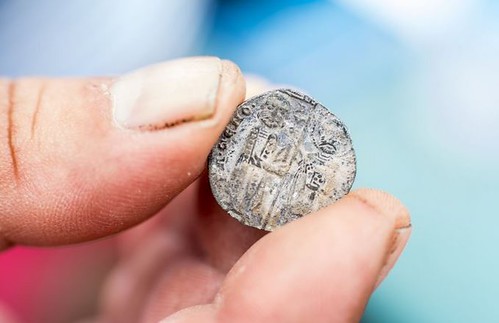 A total of three silver coins minted in the medieval Republic of Venice, an Italian city-state that was a major power in the Mediterranean, have been
discovered in very good condition by archaeologists excavating the fortress of Rusocastro in Southeast Bulgaria.
A total of three silver coins minted in the medieval Republic of Venice, an Italian city-state that was a major power in the Mediterranean, have been
discovered in very good condition by archaeologists excavating the fortress of Rusocastro in Southeast Bulgaria.
Earlier this week, the Regional Museum of History in the Black Sea city of Burgas which is conducting the digs, announced the discovery in Rusocastro of an Ancient Roman bronze horse statuette, which is seen as evidence that the site had a previously unknown shrine at the time of the Roman Empire.
To read the complete article, see:
SILVER MEDIEVAL
VENETIAN COINS DISCOVERED IN RUSOCASTRO FORTRESS IN SOUTHEAST BULGARIA
(http://archaeologyinbulgaria.com/2019/08/01/silver-medieval-venetian-coins-discovered-in-rusocastro-fortress-in-southeast-bulgaria/)

IRAN GOVERNMENT REVALUES ITS CURRENCY
Pabitra Saha passed along this article about a revaluation in Iran. Thanks. -Editor
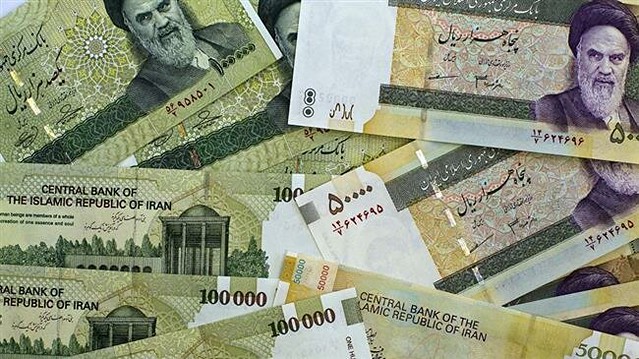 "The council of ministers, at a meeting presided by President Hassan Rouhani this morning, approved the central bank's proposed bill to
change the national currency from the rial to the toman and delete four zeros," it said. The bill by the Central Bank of Iran (CBI) to remove four zeros
from the rial was presented to the government in January, Central Bank governor Abdolnaser Hemmati said then.
"The council of ministers, at a meeting presided by President Hassan Rouhani this morning, approved the central bank's proposed bill to
change the national currency from the rial to the toman and delete four zeros," it said. The bill by the Central Bank of Iran (CBI) to remove four zeros
from the rial was presented to the government in January, Central Bank governor Abdolnaser Hemmati said then.
Iran had been weighing to drop several zeros from the rial for years, but the idea found traction after the national currency lost more than 60 percent of its value in 2018.
The reversal to the toman - in use until the 1930s - does away with a duel denomination which many visitors of Iran find confusing. While the rial is the official name, Iranians still make their calculations in toman.
The new toman will be divided into 100 rials - a tenfold redenomination of the current toman which is divided into 10 rials.
The rial went into a tailspin in anticipation of US sanctions after President Donald Trump decided to pull the United States out of a 2015 nuclear deal with Tehran and vowed “maximum pressure” on Iran's economy.
On Wednesday, the currency was trading at about 120,500 rials per US dollar on the unofficial market, up from its historic lows around 190,000 last September.
To read the complete article, see:
Iran govt. approves to drop four zeros, revert to
toman (https://www.presstv.com/Detail/2019/07/31/602314/Iran-currency-rial-central-bank-sanctions-US)
THE INVENTION OF MONEY
Arthue Shippee and Pablo Hoffman passed along this New Yorker article on the invention of money. Here's an excerpt - see the complete (excellent, but lengthy) article online. Thanks. -Editor
 Marco Polo was right to be amazed. The instruments of trade and finance are inventions, in the same way that creations of art and discoveries of
science are inventions—products of the human imagination. Paper money, backed by the authority of the state, was an astonishing innovation, one that reshaped
the world. That’s hard to remember: we grow used to the ways we pay our bills and are paid for our work, to the dance of numbers in our bank balances and
credit-card statements. It’s only at moments when the system buckles that we start to wonder why these things are worth what they seem to be worth. The credit
crunch in 2008 triggered a panic when people throughout the financial system wondered whether the numbers on balance sheets meant what they were supposed to
mean. As a direct response to the crisis, in October, 2008, Satoshi Nakamoto, whoever he or she or they might be, published the white paper that outlined the
idea of Bitcoin, a new form of money based on nothing but the power of cryptography.
Marco Polo was right to be amazed. The instruments of trade and finance are inventions, in the same way that creations of art and discoveries of
science are inventions—products of the human imagination. Paper money, backed by the authority of the state, was an astonishing innovation, one that reshaped
the world. That’s hard to remember: we grow used to the ways we pay our bills and are paid for our work, to the dance of numbers in our bank balances and
credit-card statements. It’s only at moments when the system buckles that we start to wonder why these things are worth what they seem to be worth. The credit
crunch in 2008 triggered a panic when people throughout the financial system wondered whether the numbers on balance sheets meant what they were supposed to
mean. As a direct response to the crisis, in October, 2008, Satoshi Nakamoto, whoever he or she or they might be, published the white paper that outlined the
idea of Bitcoin, a new form of money based on nothing but the power of cryptography.
The quest for new forms of money hasn’t gone away. In June of this year, Facebook unveiled Libra, global currency that draws on the architecture of Bitcoin. The idea is that the value of the new money is derived not from the imprimatur of any state but from a combination of mathematics, global connectedness, and the trust that resides in the world’s biggest social network. That’s the plan, anyway. How safe is it? How do we know what libras or bitcoins are worth, or whether they’re worth anything? Satoshi Nakamoto’s acolytes would immediately turn those questions around and ask, How do you know what the cash in your pocket is worth?
The present moment in financial invention therefore has some similarities with the period when money in the form we currently understand it—a paper currency backed by state guarantees—was first created. The hero of that origin story is the nation-state. In all good stories, the hero wants something but faces an obstacle. In the case of the nation-state, what it wants to do is wage war, and the obstacle it faces is how to pay for it.
The modern system for dealing with this problem arose in England during the reign of King William, the Protestant Dutch royal who had been imported to the throne of England in 1689, to replace the unacceptably Catholic King James II. William was a competent ruler, but he had serious baggage—a long-running dispute with King Louis XIV of France. Before long, England and France were involved in a new phase of this dispute, which now seems part of a centuries-long conflict between the two countries, but at the time was variously called the Nine-Years’ War or King William’s War. This war presented the usual problem: how could the nations afford it?
King William’s administration came up with a novel answer: borrow a huge sum of money, and use taxes to pay back the interest over time. In 1694, the English government borrowed 1.2 million pounds at a rate of eight per cent, paid for by taxes on ships’ cargoes, beer, and spirits. In return, the lenders were allowed to incorporate themselves as a new company, the Bank of England. The bank had the right to take in deposits of gold from the public and—a second big innovation—to print “Bank notes” as receipts for the deposits. These new deposits were then lent to the King. The banknotes, being guaranteed by the deposits, were as good as gold money, and rapidly became a generally accepted new currency.
This system is still with us, and not just in England. The more general adoption of the scheme, however, was not a story of uninterrupted success.
To read the complete article, see:
The Invention of Money
(https://www.newyorker.com/magazine/2019/08/05/the-invention-of-money)

SETH DICKERMAN'S COIN PORTRAITS
Found via the Society of Paper Money Collectors News & Notes, Volume V, Number 6 July 30, 2019. -Editor

To Seth Dickerman, a handful of coins is much more than spare change. "They show all kinds of nicks and scrapes," he said. "Each of these coins has been through its own unfathomable journey. You know, we don't know where it's been."
Dickerman owns a print shop in downtown San Francisco. But since the 1980s he's been photographing presidents on coins and bills.
"I think it was 1986 actually when I was looking at a dime with a picture of Roosevelt on it," he told correspondent John Blackstone. "And I just thought he was very dignified. And I didn't find that the occupants of the White House had such dignity at the time. And that's where it started. I decided to photograph presidents on currency."
The U.S. Mint decided to put presidents on coins in 1909, replacing the Indian head penny with an image of Abraham Lincoln. Up until then, the U.S. didn't put politicians on money, concerned it would make them look like the ruling monarchs on European currency.
 Now we may barely notice the presidential portraits. But on Dickerman's walls, you can't miss them.
Now we may barely notice the presidential portraits. But on Dickerman's walls, you can't miss them.
The process begins with a camera older than most of the bills and coins themselves. "This is a beautiful, old, eight-by-ten portrait camera," he said. "It's about 100 years old. It weighs about 1,000 pounds. But it's a beautiful machine for making portraits."
The camera allows him to enlarge the image as much as 10,000 percent.
The prints cost anywhere from $1,000 to $5,000. The enlargements reveal every detail, every flaw.
"When you're confronted with something so much larger than you, it gives it a certain power," he said.
And for Seth Dickerman, that is their real face value.
To read the complete article, see:
Face value: Portraits on money
(https://www.cbsnews.com/news/face-value-portraits-of-presidents-on-money-by-seth-dickerman/)
LOOSE CHANGE: AUGUST 4, 2019
Here are some additional items in the media this week that may be of interest. -Editor
Director Ryder Signs Nine 2019 Proof Sets

United States Mint Director Dave Ryder signed nine 2019 Proof Sets during a visit to the San Francisco Mint on July 22.
Director Ryder’s signature appears on the product insert, the Certificate of Authenticity (COA) and the product carton in each complete set, and each component has been numbered as well. The signed sets will be randomly distributed through the U.S. Mint’s fulfillment center as orders are packaged and shipped to customers.
What a great gesture! It's very nice of the Director to take the time to do this for some lucky random Mint customers. What a great surprise it would be to discover one of these notes in your new purchase. Be on the lookout! From CoinNews.net. -Editor
To read the complete article, see:
U.S. Mint Director Ryder Signs Nine 2019 Proof Sets For
Distribution (https://www.coinnews.net/2019/07/29/u-s-mint-director-ryder-signs-nine-2019-proof-sets/)
Online Book-Selling Scams
Bibliophiles and readers in general should be aware of several popular online book-selling scams outlines in this Los Angeles Times article. -Editor
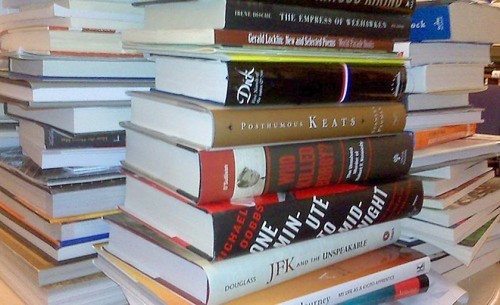 "American authors are hurting. Surveys done by the Authors Guild show that the median income of authors from writing has declined 42% in the
last 10 years. Well over half of full-time, published authors now earn below the individual poverty level from their writing.
"American authors are hurting. Surveys done by the Authors Guild show that the median income of authors from writing has declined 42% in the
last 10 years. Well over half of full-time, published authors now earn below the individual poverty level from their writing.
"While there are many reasons for this, one factor is the surge in book-selling scams: counterfeiting, author “doppelganging,” title cloning, ebook piracy, cut-and-paste plagiarism and other rip-offs — many of which take place on digital platforms like Amazon, Ebay and Google. The variety and cleverness of these cons is breathtaking."
To read the complete article, see:
Op-Ed: Online book-selling scams steal a living from
writers (https://www.latimes.com/opinion/story/2019-07-25/amazon-books-counterfeit-authors-copyright)
MORE ON THE BANK OF ENGLAND MUSEUM EXHIBIT
Here's another article, this time from The Economist about the new exhibit at the Bank of England. I particularly enjoyed this origami flower made from banknotes. -Editor

A new exhibition at the Bank of England Museum is a reminder of the efforts both to establish and subvert the idea of money over time.
The central bank turns 325 this year. To celebrate this anniversary the bank has raided its archives for 325 objects that are broadly representative of its history (a recent two-part BBC documentary has also shown its inner workings). Unsurprisingly, many of the objects on display are money or ways of accounting for it. A tally stick dates from 1694,
To read the complete article, see:
A show at the Bank of England
underscores the strange fiction of money
(https://www.economist.com/prospero/2019/07/30/a-show-at-the-bank-of-england-underscores-the-strange-fiction-of-money)
To read the complete article, see:
NEW BANK OF ENGLAND MUSEUM EXHIBIT (https://www.coinbooks.org/v22/esylum_v22n27a13.html)
FEATURED WEB SITE: COIN HOARDS OF THE ROMAN EMPIRE
This week's Featured Web Site is Coin Hoards of the Roman Empire from the Ashmolean Museum.
The Coin Hoards of the Roman Empire Project is a joint initiative of the Ashmolean Museum and the Oxford Roman Economy Project. It is the brainchild of Baron Lorne Thyssen-Bornemisza and is funded by the Augustus Foundation. It intends to fill a major lacuna in the digital coverage of coin hoards from antiquity. It aims to collect information about hoards of all coinages in use in the Roman Empire between approximately 30 BC and AD 400. Imperial Coinage forms the main focus of the project, but Iron Age and Roman Provincial coinages in circulation within this period are also included to give a complete picture of the monetary systems of both the West and the East. In 2019 the scope of the Project was extended to include hoards of Roman coins from outside the Empire. The intention of the Project is to provide the foundations for a systematic Empire-wide study of hoarding and to promote the integration of numismatic data into broader research on the Roman Economy.
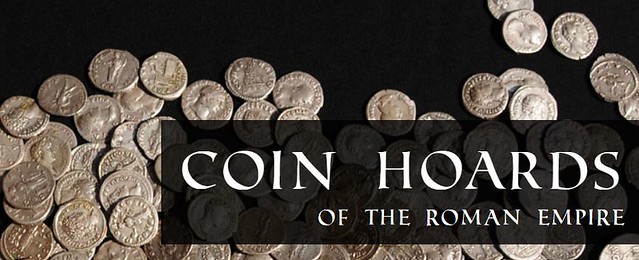
http://chre.ashmus.ox.ac.uk/

